LG Electronics USA KS20 PCS GSM/ EDGE Phone with WLAN and Bluetooth User Manual
LG Electronics USA PCS GSM/ EDGE Phone with WLAN and Bluetooth Users Manual
Users Manual

Disposal of your old appliance
1. When this crossed-out wheeled bin symbol is attached to a product it means the
product is covered by the European Directive 2002/96/EC.
2. All electrical and electronic products should be disposed of separately from the
municipal waste stream via designated collection facilities appointed by the
government or the local authorities.
3. The correct disposal of your old appliance will help prevent potential negative
consequences for the environment and human health.
4. For more detailed information about disposal of your old appliance, please contact
your city office, waste disposal service or the shop where you purchased the
product.
KS20 User Guide
- English
This document is the user guide for the LG KS20
3G Video Mobile Phone. All rights for this document
are reserved by LG Electronics. Copying, modifying
and distributing this document without the consent
of LG Electronics are prohibited.
Part 15.21 statement
" Change or Modifications that are not expressly approved by the manufacturer could void
the user's authority to operate the equipment. "
Part 15.105 statement
This equipment has been tested and found to comply with the limits for a class B digital device,
pursuant to Part 15 of the FCC Rules.
These limits are designed to provide reasonable protection against harmful interference in a
residential installation.
This equipment generates uses and can radiate radio frequency energy and, if not installed and used
in accordance with the instructions, may cause harmful interference to radio communications.
However, there is no guarantee that interference will not occur in a particular installation. if this
equipment does cause harmful interference or television reception, which can be determined by
turning the equipment off and on, the user is encouraged to try to correct the interference by one or
more of the following measures:
- Reorient or relocate the receiving antenna.
- Increase the separation between the equipment and receiver.
- Connect the equipment into an outlet on a circuit different from that to
which the receiver is connected
- Consult the dealer or an experienced radio/TV technician for help.
LIMITED WARRANTY STATEMENT
1. WHAT THIS WARRANTY COVERS:
LG offers you a limited warranty that the enclosed subscriber unit and its enclosed accessories will be
free from defects in material and workmanship, according to the following terms and conditions:
(1) The limited warranty for the product extends for ONE (1) year beginning on the data of purchase
of the product.
(2) The limited warranty extends on to the original purchaser of the product and is not assignable or
transferable to any subsequent purchaser/end user.
(3) This warranty is good only to the original purchaser of the product during the warranty period as
long as it is in the U.S., including Alaska, Hawaii, U.S. Territories and Canada.
(4) The external housing and cosmetic parts shall not be covered under these limited warranty terms.
(5) Upon request from LG, the consumer must provide information to reasonably prove the date of
purchase.
(6) The customer shall bear the cost of shipping the product to the Customer Service Department of
LG. LG shall bear the cost of shipping the product back to the consumer after the completion of
service under this limited warranty.
2. WHAT THIS WARRANTY DOES NOT COVER:
(1) Defects or damages resulting from use of the product in other than its normal and customary
manner.
(2) Defects or damages from abnormal use, abnormal conditions, improper storage, exposure to
moisture or dampness, unauthorized modifications, unauthorized connections, unauthorized repair,
misuse, neglect, abuse, accident, alteration, improper installation, or other acts which are not the
fault of LG, including damage caused by shipping blown fuses spills of food or liquid.
(3) Breakage or damage to antennas unless caused directly by defects in material or workmanship.
(4) That the Customer Service Department at LG was net notified by consumer of the alleged defect
or malfunction of the product during the applicable limited warranty period.
(5) Products which have had the serial number removed or made illegible.
(6) The limited warranty is in lieu of all other warranties, express or implied either in fact or by
operations law, statutory or otherwise, including, but limited to any implied warranty of
marketability or fitness for a particular use.
(7) Damage resulting from use of non-LG approved accessories.
(8) All plastic surfaces and all other externally exposed parts that are scratched or damaged due to
normal customer use.
(9) Products operated outside published maximum ratings.
3
(10) Products used or obtained in a rental program.
(11) Consumables (such as fuses).
3. STATE LAW RIGHTS:
No other express warranty is applicable to this product. THE DURATION OF ANY IMPLIED
WARRANTIES, INCLUDING THE IMPLIED WARRANTY OF MARKETABILITY, IS LIMITED
TO THE DURATION OF THE EXPRESS WARRANTY HEREIN. LG INFOCOMM INC. SHALL
NOT BE LIABLE FOR THE LOSS OF THE USE OF THE PRODUCT, INCONVENIENCE, LOSS
OR ANY OTHER DAMAGES, DIRECT OR CONSEQUENTIAL, RISING OUT OF THE USE OF,
OR INABILITY TO USE, THIS PRODUCT OR FOR ANY BREACH OF ANY EXPRESS OR
IMPLIED WARRANTY, INCLUDING THE IMPLIED WARRANTY OF MARKETABILITY
APPLICABLE TO THIS PRODUCT. Some states do not allow the exclusive of imitation of incidental
or consequential damages or limitations on how long an implied warranty lasts; so these limitations or
exclusions may not apply to you. This warranty gives you specific legal rights and you may also have
other rights which vary from state to state.
4. HOW TO GET WARRANTY SERVICE:
To obtain warranty service, please call the following web address:
www.lgeservice.com

8
For Your Safety
Important Information
This user guide contains important information on the use and
operation of this phone. Please read all the information
carefully for optimal performance and to prevent any damage
to or misuse of the phone. Any changes or modifications not
expressly approved in this user guide could void your warranty
for this equipment.
Before You Start
Safety Instructions
WARNING! To reduce the possibility of electric shock, do not
expose your phone to high humidity areas, such as the
bathroom, swimming pool, etc.
Always store your phone away from heat. Never store your
phone in settings that may expose it to temperatures less than
32°F or greater than 104°F, such as outside during extreme
weather conditions or in your car on a hot day. Exposure to
excessive cold or heat will result in malfunction, damage
and/or catastrophic failure.
Be careful when using your phone near other electronic
devices. RF emissions from your mobile phone may affect
nearby in adequately shielded electronic equipment. You
should consult with manufacturers of any personal medical
devices such as pacemakers and hearing aides to determine if
they are susceptible to interference from your mobile phone.
Turn off your phone in a medical facility or at a gas station.
Never place your phone in a microwave oven as this will
cause the battery to explode.
IMPORTANT! Please read the TIA SAFETY INFORMATION on
page 78 before using your phone.
Safety Information
Read these simple guidelines. Breaking the rules may be
dangerous or illegal. Further detailed information is given in this
user guide.
]Never use an unapproved battery since this could damage
the phone and/or battery and could cause the battery to
explode.
]Never place your phone in a microwave oven as it will
cause the battery to explode.
]Do not dispose of your battery by fire or with hazardous or
flammable materials.
]Make sure that no sharp-edged items come into contact
with the battery. There is a risk of this causing a fire.
]Store the battery in a place out of reach of children.
]Be careful that children do not swallow any parts such as
rubber plugs (earphone, connection parts of the phone,
etc.). This could cause asphyxiation or suffocation.

9
For Your Safety
]Unplug the power cord and charger during lightning storms
to avoid electric shock or fire.
]When riding in a car, do not leave your phone or set up the
hands-free kit near to the air bag. If wireless equipment is
improperly installed and the air bag is activated, you may be
seriously injured.
]Do not use a hand-held phone while driving.
]Do not use the phone in areas where its use is prohibited.
(For example: aircraft).
]Do not expose the battery charger or adapter to direct
sunlight or use it in places with high humidity, such as a
bathroom.
]Never store your phone in temperatures less than- 4°F or
greater than 122°F.
]Do not use harsh chemicals (such as alcohol, benzene,
thinners, etc.) or detergents to clean your phone. There is a
risk of this causing a fire.
]Do not drop, strike, or shake your phone severely. Such
actions may harm the internal circuit boards of the phone.
]Do not use your phone in high explosive areas as the phone
may generate sparks.
]Do not damage the power cord by bending, twisting, pulling,
or heating. Do not use the plug if it is loose as it may cause
a fire or electric shock.
]Do not place any heavy items on the power cord. Do not
allow the power cord to be crimped as it may cause fire or
electric shock.
]Do not handle the phone with wet hands while it is being
charged. It may cause an electric shock or seriously
damage your phone.
]Do not disassemble the phone.
]Do not place or answer calls while charging the phone as it
may short-circuit the phone and/or cause electric shock or
fire.
]Only use the batteries, antennas, and chargers provided by
LG. The warranty will not be applied to products provided by
other suppliers.
]Only authorized personnel should service the phone and its
accessories. Faulty installation or service may result in
accidents and consequently invalidate the warranty.
]Do not hold or let the antenna come in contact with your
body during a call.
]An emergency call can be made only within a service area.
For an emergency call, make sure that you are within a
service area and that the phone is turned on.

10
For Your Safety
FCC RF Exposure Information
WARNING! Read this information before operating the phone.
In August 1996, the Federal Communications (FCC) of he United
States, with its action in Report and Order FCC 96-326, adopted
an updated safety standard for human exposure to radio
frequency (RF) electromagnetic energy emitted by FCC
regulated transmitters. Those guidelines are consistent with
the safety standard previously set by both U.S. and
international standards bodies.
The design of this phone complies with the FCC guidelines and
these international standards.
CAUTION
Use only the supplied and approved antenna. Use of
unauthorized antennas or modifications could impair call
quality, damage the phone, void your warranty and/or result in
violation of FCC regulations. Do not use the phone with a
damaged antenna. If a damaged antenna comes into contact
with skin, a minor burn may result. Contact your local dealer
for a replacement antenna.
Body-worn Operation
This device was tested for typical body-worn operations with
the back of the phone kept 0.79 inches (2cm) between the
user’s body and the back of the phone. To comply with FCC RF
exposure requirements, a minimum separation distance of 0.79
inches(2cm) must be maintained between the user's body
and the back of the phone. Third-party belt-clips, holsters, and
similar accessories containing metallic components should not
be used. Body-worn accessories that cannot maintain 0.79
inches(2cm) separation distance between the user's body
and the back of the phone, and have not been tested for typical
body-worn operations may not comply with FCC RF exposure
limits and should be avoided.

11
For Your Safety
Vehicle Mounted External Antenna
(optional, if available)
A minimum separation distance of 8 inches (20cm) must be
maintained between the user/bystander and the vehicle
mounted external antenna to satisfy FCC RF exposure
requirements. For more information about RF exposure, visit
the FCC website at www.fcc.gov
FCC Part 15 Class B Compliance
This device and its accessories comply with part 15 of FCC
rules. Operation is subject to the following two conditions:
(1) This device and its accessories may not cause harmful
interference, and (2) this device and its accessories must
accept any interference received, including interference that
may cause undesired operation.
Cautions for Battery
]Do not disassemble.
]Do not short-circuit.
]Do not expose to high temperature: 60°C (140°F).]
]Do not incinerate.
Battery Disposal
]Please dispose of your battery properly or bring to your
local wireless carrier for recycling.
]Do not dispose in fire or with hazardous or flammable
materials.
Adapter (Charger) Cautions
]Using the wrong battery charger could damage your phone
and void your warranty.
]The adapter or battery charger is intended for indoor use
only.
Do not expose the adapter or battery charger to direct sunlight
or use it in places with high humidity, such as the bathroom.

15
PART OF THE PHONE
Front view
1. Earpiece
2. Touch Screen
Use to write, draw, or make a selection with
the stylus.
3. Send Key
v Dials a phone number and answers
incoming calls.
4. OK Key
5. Internal camera lens
6. End Key
v Ends or rejects a call.
FEATURES
KS20 features

16
Side view
1. Charger/Cable/Handsfree
connector
2. Side Keys
v Press up or down to adjust the volume.
3. Stylus and Stylus Slot
v Use the stylus to write, draw, or select items
on the touch screen.
4. Power key
v Press to turn o your device temporarily and
switches the device to sleep mode; press an
d hold (about ve seconds) to turn o your
device completely.
When your device is in sleep mode, you can
still use the phone function to receive calls;
however, the phone function is o when
you turn o the device completely.
5. MiniSD Card Slot
6. Internet Explorer
7. Camera key
v Press this key shortly to enter MP3 menu.
v Press and hold this key to activate camera.
FEATURES
KS20 features

17
Rear view
Flash
External
Camera Lens
Cable connector/
Battery charging connector
Battery
KS20 features

18
KS20 FEATURES
KS20 features
v
This product’s keys on the LCD screen are touch keys.
v
Be sure to read “Cautions for Touch Keys” before using this product.
CAUTIONS FOR
TOUCH KEYS
1. Make sure your hands are clean
and dry.
v
Remove all moisture from the
surface of your hands or the touch
keys in a humid environment.
2. You do not need to press hard on
the touch keys to make them work.
Do not subject the product to severe
impact, as this may damage the
touch key sensors.
3. Use the tip of your finger to press
exactly on the touch key you want,
being careful not to touch the keys
for other functions.
4. When both the home screen and
touch key lights are off, pressing a
touch key will not turn on the home
screen light. Press
E
and the
home screen light will turn back
on(touch keys do not work when the
touch key lights are off).
5. Touch keys may not work normally if
a mobile phone case or plastic cover
is covering them. Also, touch keys
may not work if you are wearing
gloves.
Touch keypad
Hard keys

19
6. Keep metal and other conductive
materials away from the surface of
the touch keys, as contact with them
may result in an error.
7. This phone does not allow to use
a pen or a stylus to select menu. If
you use a pen or a stylus, the menus
cannot be activated properly. Use
the phone by only finger.
8. Touch key cannot be activated
properly in hot and humid
environment.
KS20 features

20
GETTING STARTED
Getting Started
INSTALLING THE USIM
CARD AND BATTERY
1. Installing the USIM card.
Your USIM card contains your
phone number, service details and
contacts and must be inserted into
your handset. If your USIM card is
removed then your handset becomes
unusable (except for emergency calls
depending on which Country you
are in at the time) until a valid one
is inserted. Always disconnect the
charger and other accessories from
your handset before inserting and
removing your USIM card. Slide the
USIM card into the USIM card holder.
Make sure that the USIM card is
properly inserted and the gold contact
area on the card is facing downwards.
To remove the USIM card, press
down lightly and pull it in the reverse
direction.

21
Note
v
The metal contact of the USIM
card can easily be damaged by
scratches. Pay special attention
to the USIM card while handling.
Follow the instructions supplied
with the USIM card.
2. Installing the battery.
Insert the the battery into the battery
compartment as the metal contacts
meet in the middle of the phone.
Push down the top of the battery until
it snaps into place. Place the battery
cover to the phone as shown.
3. To remove the battery.
Turn the phone up-side down, as
shown, gently push down the battery
cover to release and lift off. Then lift up
the battery with your fingers and pull-
out the battery.
Getting Started

22
CHARGING THE BAT
TERY
Before connecting the travel adapter
to the phone you must first install the
battery.
1. With the arrow facing you as shown
in the diagram push the plug on the
battery adapter into the socket on
the right side of the phone.
2. Connect the other end of the travel
adapter to the mains socket.
Note
v
Only use the charger included in
the box.
GETTING STARTED
Getting Started

23
CAUTION!
• If the battery is completely discharged,
the charging display will appear on the
LCD approximately 1 to 1.5 minutes after
connecting TA.
• Do not force the connector as this may
damage the phone and/or the travel
adapter.
• Insert the battery pack charger vertically
to wall power outlet.
• If you use the battery pack charger when
abroad, use an attachment plug adaptor
for the proper configuration.
• Do not remove your battery or the USIM
card while charging.
WARNNING
• Unplug the power cord and charger
during lightning storms to avoid electric
shock or fire.
• Make sure that no sharp-edged items
such as animal teeth or nails, come into
contact with the battery. This may cause
a fire.
DISCONNECTING THE
CHARGER
Disconnect the travel adapter from the
phone as shown in the diagram below.
Getting Started

24
HOW TO USE A MI
CROSD MEMORY
CARD
<MicroSD memory card>
<How to insert a microSD memory
card>
1. Turn the phone off. Inserting or
removing the microSD when the
phone is on may damage the files
stored in the memory card.
2. Lift the plastic cover which protects
the microSD slot.
GETTING STARTED
Getting Started

25
3. Insert the memory card into the
slot with the metal contacts facing
down. Do not force the memory
card into the slot, if the card does
not slide in easily, please check that
the card is being inserted the correct
way or if there is a foreign object in
the slot.
4. Once inserted, push the memory
card until you hear a Click, meaning
that the microSD has been correctly
engaged.
5. Close the plastic slot protection.
6. To remove the memory card,
turn the phone off, open the slot
protection and push in memory
card with the tip of your finger into
the slot which will activate the eject
mechanism.
Attention:
v Avoid using the Flash Memory Card
when the battery is low.
v When writing to the card, wait for
the operation to complete before
removing the card.
v The card is designed to fit easily into
the system one way only.
v Do not bend the card or force it into
the slot.
v Do not insert any memory cards
other than those made by microSD.
Getting Started

26
v If the microSD has been formatted
using FAT32, format the microSD
using FAT16 again.
For more information on the microSD,
please refer to the memory card
instruction manual.
MEMORY CARD
FORMATTING
Before you start to use the memory
card you have to format it. After you
insert the memory card, tap Start o
Settings o System o Memoryo
Storage Card, and follow the
instructions on the screen.
This operation should only be done
when you insert the memory card
for the first time. During formatting
various folders will be created for
different data types.
TURN THE DEVICE ON
AND OFF
To turn on the device, press the
POWER button. When you turn on the
device for the first time, you are asked
to complete a calibration process. For
more information, see “Calibrate the
device” on next page.
To turn off the device, press
P
again.
Note
v
Pressing
P
turns off your device
temporarily and switches the
device to sleep mode. However,
you can still receive messages and
calls while your device is in the
sleep mode.
GETTING STARTED
Getting Started

27
Access codes
You can use the access codes
described in this section to avoid
unauthorised use of your phone. The
access codes (except the PUK and
PUK2 codes) can be changed by using
the Change codes feature [Menu
#.1.4.3].
PIN code (4 to 8 digits)
The PIN (Personal Identification
Number) code protects your USIM
card against unauthorised use. The
PIN code is usually supplied with the
USIM card. When the PIN code request
is set to On, your phone will request
the PIN code every time it is switched
on. When the PIN code request is set
to Off, your phone connects to the
network directly without the PIN code.
PIN2 code (4 to 8 digits)
The PIN2 code, supplied with some
USIM cards, is required to access
functions such as Fixed dial number.
These functions are only available if
supported by your USIM card.
PUK code (8 digits)
The PUK (PIN Unblocking Key) code
is required to unblock a blocked PIN
code. The PUK code may be supplied
with the USIM card. If not, contact
your network operator’s customer
service department for the code.
If you lose the code, contact your
network operator’s customer service
department.
Getting Started

28
PUK2 code (8 digits)
The PUK2 code, supplied with some
USIM cards, is required to unblock
a blocked PIN2 code. If you lose the
code, contact your network operator’s
customer service department.
Security code (4 digits)
The security code prevents
unauthorised use of your phone. The
default security code is set to ‘0000’
and the security code is required to
delete all phone entries and to restore
the handset to the factory settings.
TURN ON AND OFF
FLIGHT MODE
In many countries you are required by
law to turn off your phone onboard an
aircraft. Turning off the power doesn’t
turn off the phone. You must activate
flight mode in order to turn off the
phone.
You can turn on flight mode and still
keep your device turned on and use
other functions.
v Tap the Signal icon (
), and tap
Turn on flight mode to turn off the
phone.
v To resume call function, make flight
mode unavailable by tapping Turn
off flight mode.
GETTING STARTED
Getting Started

29
CALIBRATE THE DE
VICE
Calibrating the device screen involves
tapping with the stylus the center of
a cross as it moves around the screen.
This process ensures that when you
tap the screen with your stylus, the
tapped item is activated.
If your device does not accurately
respond to screen taps, follow these
steps to re-calibrate it:
1. Tap Start > Settings > System tab
> Screen.
2. On the General tab, tap Align
Screen, and follow the instructions
on the screen.
BUTTONS LOCK
It is possible to lock the buttons on the
device, so that the applications may
not be accidentally launched. Once
you enable this feature, only the Power
button can turn on your device.
Getting Started

30
To configure the Buttons Lock
settings
v
Tap Start > Settings > Personal tab
> Buttons. On the Lock tab, select
the Lock all buttons except Power
button check box.
MANAGE SCREEN
SETTINGS
The device touch screen has three
orientation modes: Portrait, Landscape
(right-handed), and Landscape (left-
handed). Portrait mode allows you to
get a better view or a better operation
of certain programs on your device,
while Landscape mode may be
optimal for viewing longer text files.
v
To change the orientation, tap Start
> Settings > System tab > Screen,
and select the orientation you want.
ETTING STARTED
Getting Started

31
v
To smooth the edges of screen
fonts for many programs, on the
ClearType tab, select the Enable
ClearType check box.
v
To increase the readability or to see
more content on the screen, on the
Text Size tab, adjust the text size by
moving the slider.
Getting Started
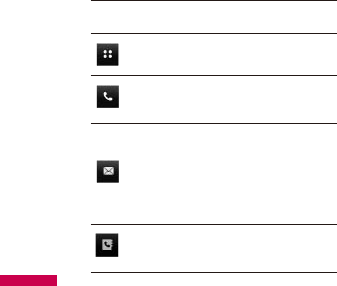
32
SCREEN INFORMATION
Screen information
Icon Description
Used to enter menu directly.
Used to make a call or send
text/ multimedia message.
Used to send the text/
multimedia message and
to view the messages in the
inbox. You can activate various
functions related to messages.
Used to access the phonebook
list.
THE TODAY SCREEN
The Today screen displays important
information, such as upcoming
appointments and status indicators.
You can tap a section on the screen to
open the associated program.
v
To access the Today screen, tap Start
> Today.
v
To customize the Today screen
display, including the background
image, tap Start > Settings >
Personal tab > Today.

33
Default MS Today Screen
Phone information
4. Owner information
5. Unread message
6. Upcoming task
7. Upcoming schedule
8. Device lock
9. Device unlock
10.
Indicators: Prole, battery, network
11. Bluetooth
13. Link to Phone
14. Link for Contacts
Screen information

34
Today screen with focus at Call
History
Press in the Today screen display.
Today screen with focus at
Messaging
Press in the Today screen display.
SCREEN INFORMATION
Screen information

35
Today screen with focus at live!
Press in the Today screen display.
Today > Device lock
Screen information
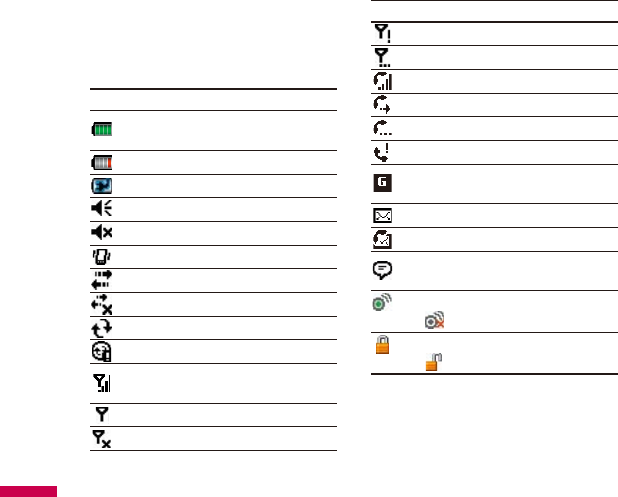
36
Indicators
Following are some of the status icons
that you may see on your device.
Icon Description
Indicates the battery is fully
charged.
Indicates the battery is very low.
Battery charging.
Sound on.
Sound off.
Ringer in vibration mode.
Connection is active.
Connection is not active.
Synchronization in progress.
Synchronization error.
Indicates maximum signal
strength.
No signal.
Phone is turned off.
Icon Description
No phone service.
Searching for phone service.
Voice call in progress.
Calls are forwarded.
Call on hold.
Missed call.
GPRS (General Packet Radio
Services) available
New e-mail or text messages.
New voice mail
There are more notifications. Tap
the icon to view all.
Indicates Wi-Fi is turned on.
Wi-Fi off.
Indicates the device is locked.
Device unlocked.
Screen information
SCREEN INFORMATION

37
USING THE START
MENU
The Start menu, located at the top left
corner of the Today screen, displays
a list of programs. It lets you close a
screen and switch from one program
to another. You can start a program
by scrolling through the programs list
and then pressing
O
, or by tapping a
program with the stylus.
Tap to start a program. The items
displayed in Start menu can be
customized by tapping Start >
Settings > Personal tab > Menus.
3. Tap to start a recently-used program.
4. Tap to view and select more
programs that are installed in your
device.
5. Tap to change device settings.
6. Tap to see a Help topic for the
current screen.
Program Indicators
Following are some of the icons for the
programs that are already installed on
your device.
Icon Description
ActiveSync Synchronizes
information between your device
and a PC.
Screen information
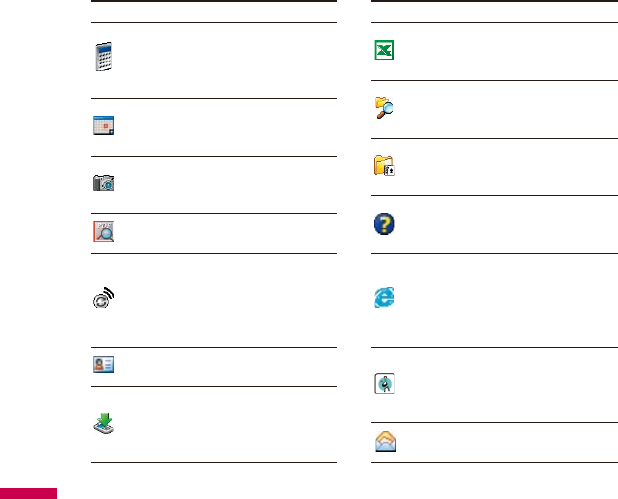
38
Icon Description
Calculator Performs basic
arithmetic and calculations,
such as addition, subtraction,
multiplication, and division.
Calendar Keeps track of your
appointments and creates
meeting requests.
Camera Snaps photos or shoots
video clips with accompanying
audio.
ClearVue PDF enables you to
view PDF files on your Pocket PC.
Comm Manager Allows you to
manage the device’s connection
(including Wi-Fi, Bluetooth, and
ActiveSync), and switch the
ringer/ vibration mode.
Contacts Keeps track of your
friends and colleagues.
Download Agent Provides
information about the download
status and the downloaded
content from the Internet.
Icon Description
Excel Mobile Creates new
workbooks or lets you view and
edit Excel workbooks.
File Explorer Enables you to
organize and manage files on your
device.
Games Lets you play two
pre-installed games: Bubble
Breaker and Solitaire.
Help Enables you to see Help
topics for a program on your
device.
Internet Explorer Internet
Explorer browses Web and
WAP sites, and downloads new
programs and files from the
Internet.
JAVA Enables you to download
and install Java applications,
such as games and tools, on your
device.
Messaging Sends and receives
e-mail and text messages.
SCREEN INFORMATION
Screen information
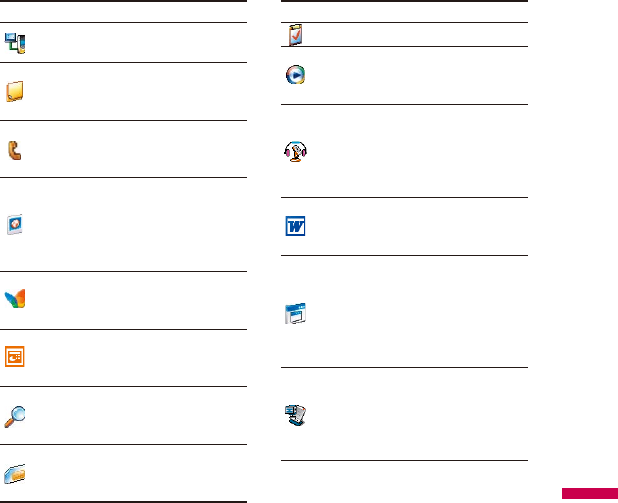
39
Icon Description
Modem Link Allows you to use
your device as a modem.
Notes Creates handwritten
or typed notes, drawings, and
recordings.
Phone Makes and receives calls,
switches between calls and sets
up conference calling.
Pictures & Videos Collects,
organizes, and sorts picture and
video files in the My Pictures
folder of your device or on a
storage card.
Pocket MSN Sends and receives
instant messages with your MSN
Messenger contacts.
PowerPoint Mobile Lets you view
and edit PowerPoint slides and
presentations.
Search Enables you to search
contacts, data, and other
information on your device.
SIM Manager Collects, organizes
and sorts the contact list stored in
your SIM card.
Icon Description
Tasks Keeps track of your tasks.
Windows Media Enables the
multimedia function on your
device.
Voice Speed Dial You can record
voice tags so that you can dial
a phone number or launch
programs simply by speaking a
word.
Word Mobile Creates new
documents or lets you view and
edit Word documents
Terminal Services Client Allows
you to log on a PC running
Terminal Services or Remote
Desktop, and use all of the
programs available on that PC
from your mobile device.
Zip Enables you to save memory
and increase the storage capacity
of your device by compressing
files in the conventional ZIP
format.
Screen information

40
INTRODUCTION
When you start a program or select
a field that requires text or numbers,
Input Panel automatically becomes
available. Input Panel provides
access to the various input methods
available on your device, including
Block Recognizer, Keyboard, Letter
Recognizer, and Transcriber. By
default, the Input Panel icon appears
on the menu bar to indicate which
input method is currently selected.
The Input Selector arrow (shown at
the right side of the Input Panel icon)
opens a list of available input methods.
Overview of Input Panel
v
Input Panel, which is available when
text entry is possible, provides
access to the various input methods
available on your device.
v
By default, Input Panel appears
as on the menu bar. The
above icons indicate which input
method is currently selected. The
Input Selector arrow opens a list of
available input methods.
v
To show or hide Input Panel, tap the
Input Panel icon on the menu bar.
TERING AND SEARCHING INFOR
MATION
Entering and Searching Information
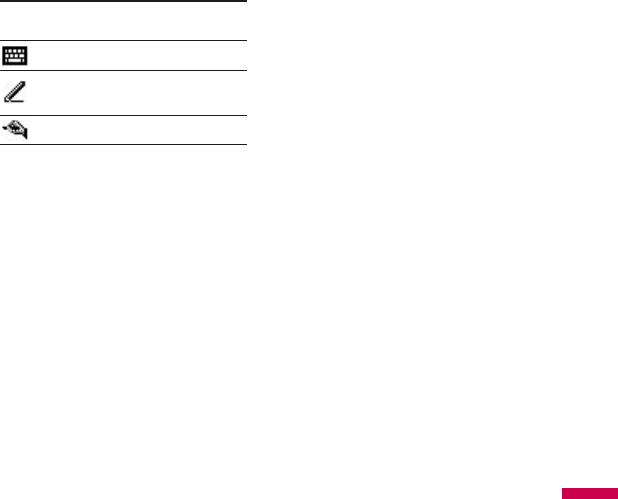
41
Icon Indicates the selected input
method is
The on-screen keyboard.
Letter Recognizer or Block
Recognizer.
Transcriber (if available).
USING THE KEY
BOARD
To enter text, symbols, and numbers,
you can either type using the QWERTY
Keyboard or the standard on-screen
Keyboard. For use of the QWERTY
keyboard, see the instruction in
Chapter 1.
Using the standard on-screen
Keyboard
The on-screen Keyboard is available
when text entry is possible. You can
enter text by tapping keys on the
keyboard that are displayed on the
screen.
Enter text using the on-screen
keyboard
v
The on-screen keyboard is available
when text entry is possible.
v
To make the keys larger, tap the
Input Selector arrow, and then
Options. In the Input method list,
select Keyboard, and then tap Large
Keys.
v
General rule for entering text is
same as MS based PC.
Entering and Searching Information

42
Using Letter Recognizer
With Letter Recognizer, you can
write individual letters, numbers,
and punctuation, which are then
converted into typed text.
Enter text using Letter Recognizer
v
Letter Recognizer is available when
text entry is possible.
v
Preferred word list will be
disappeared if there is no user
reaction for 3 seconds.
USING BLOCK
RECOGNIZER
With Block Recognizer, you use a
single stroke to write letters, numbers,
symbols, and punctuation, which are
then converted into typed text.
ENTERING AND SEARCHING INFORMATION
Entering and Searching Information

43
Enter text using Block
Recognizer
v
Block Recognizer is available when
text entry is possible.
v
With Block Recognizer, you use
a single stroke to write letters,
numbers, symbols, and punctuation,
which are then converted into typed
text.
v
Preferred word list will be
disappeared if there is no user
reaction for 3 seconds.
v
Enter letters by writing in the abc
(left) area of the box.
v
Enter numbers by writing in the 123
(right) area of the box.
v
Enter symbols and punctuation by
tapping in either area of the box and
then writing the desired character.
Entering and Searching Information

44
SING TRANSCRIBER
Transcriber is a handwriting
recognition program that allows
you to write in cursive, print, or a
combination of both. Transcriber
works transparently in the background
of programs, recognizing words
with its integrated dictionary. When
Transcriber is turned on, it interprets
stylus movement anywhere on the
screen as handwriting input. For more
information about using Transcriber,
see Help on your device.
To start Transcriber
1. Start a program that accepts user
input, such as Word Mobile.
2. Tap the Input Selector arrow, and
tap Transcriber. The Transcriber
introductory screen appears.
ENTERING AND SEARCHING INFORMATION
Entering and Searching Information

45
To write using Transcriber
1. In a program, position the cursor
where you want text to appear.
2. Use the stylus to write anywhere on
the screen. The handwriting will be
converted to text shortly after you
lift the stylus from the screen.
To enter punctuation and symbols
Transcriber comes with an on-screen
keyboard that provides an easy way to
add punctuation or a special symbol
to existing text.
v
From a program, tap on the
Transcriber toolbar. The keyboard
remains visible until you tap the
button again.
Note
v
To reposition the keyboard, tap and
hold the title bar, then drag to the
desired location.
When no text is selected, you can
also open the keyboard by doing
the gesture.
To edit text
1. In a program, draw a line across the
text you want to edit.
2. After you lift the stylus from the
screen, the line will disappear and
the selected text will be highlighted.
3. Do either of the following:
v
Rewrite the text.
v
Use gestures to capitalize letters,
insert a space, and so on. For
information about using gestures,
see “Transcriber Gestures” in this
chapter.
Entering and Searching Information
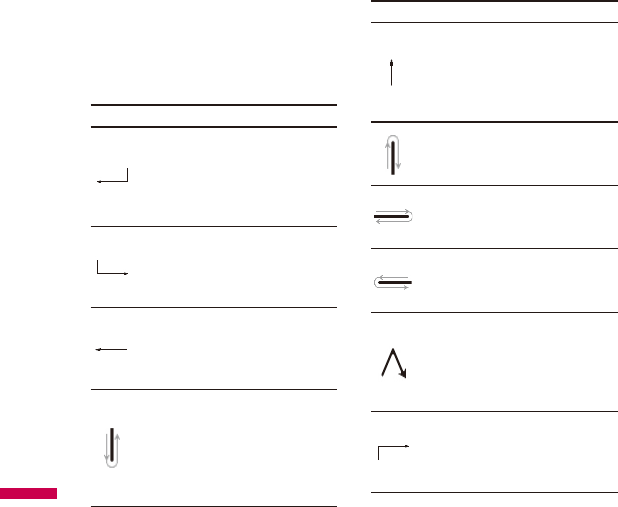
46
Transcriber Gestures
Use quick strokes of the stylus to edit
your text or to insert returns, spaces,
or tabs.
Do To
Insert a paragraph return at the
cursor.
The horizontal portion of the
gesture must be at least two times
longer than the vertical portion.
Insert a space at the cursor.
The horizontal portion of the
gesture must be at least two times
longer than the vertical portion.
Move the cursor one space back
and erase any text.
Do the gesture by drawing a line
from right to left.
Open the menu of alternate
words if a word is selected or the
onscreen Transcriber keyboard if
no text is selected.
Do the gesture by drawing a line
straight down and back up.
Do To
Change the capitalization of a
selected letter, word, or block of
text.
Do the gesture by drawing a line
straight up.
Undo the last action.
Do the gesture by drawing a line
straight up and back down.
Copy the selected text.
Do the gesture by drawing a line
from left to right and back.
Cut the selected text.
Do the gesture by drawing a line
from right to left and back.
Paste copied or cut text.
Do the gesture by drawing a line
from the lower left of the screen
diagonally up toward the right
and back down to the right.
Insert a tab.
The horizontal portion of the
gesture must be at least two times
longer than the vertical portion.
ENTERING AND SEARCHING INFORMATION
Entering and Searching Information
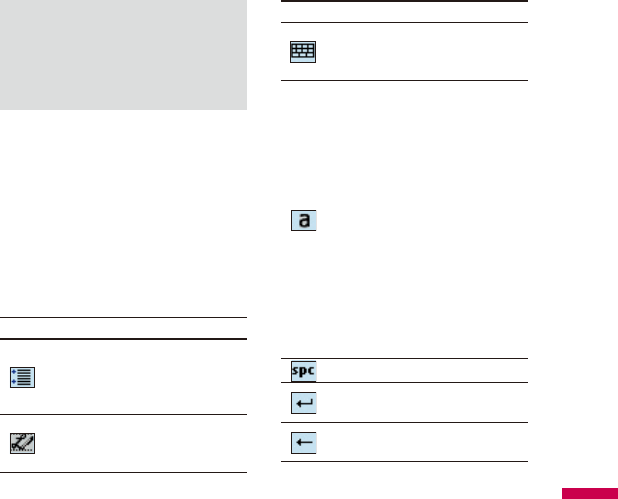
47
Note
v
You can also use the Enter, Space,
and Backspace buttons on the
Transcriber toolbar.
The Transcriber toolbar
The Transcriber toolbar, which appears
at the bottom of the screen when
Transcriber is open, provides easy
access to several tools, Enter, Space,
and Backspace buttons, and Left and
Right arrow buttons.
Tap To
Open the Options dialog box,
where you can set options such as
writing direction, text entry, and
shorthand.
Open Letter Shapes, where you
can set your personal writing
styles to maximize recognition.
Tap To
Use the miniature keyboard
to quickly enter numbers,
punctuation, and other symbols.
Change the character recognition
mode.
• a mode. This is the default
for optimum handwriting
recognition.
• 123 mode. Numbers and some
letters are allowed and the
calculator is activated.
• A mode. All letters are
automatically capitalized.
If you are in A or 123 mode,
recognition returns automatically
to the default mode once you lift
the stylus.
Insert a space at the cursor.
Insert a paragraph return at the
cursor.
Move the cursor one space to the
left.
Entering and Searching Information
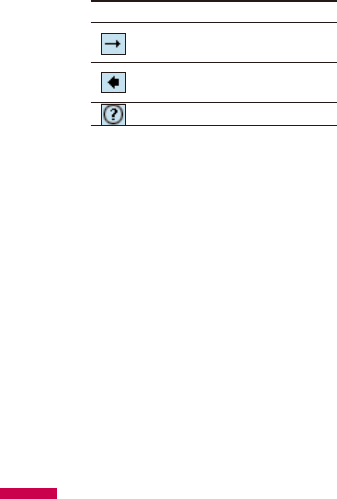
48
Tap To
Move the cursor one space to the
right.
Move the cursor one space back
and erase any text.
back and erase any text.
DRAWING AND WRIT
ING ON THE SCREEN
With your device, you can draw
directly on the screen, or write on the
screen and save notes in your own
handwriting. To do this, you must set
the input mode in Notes to Writing.
If you prefer to use handwriting or
frequently add drawings to your notes,
you may find it helpful to set Writing as
the default input mode. If you prefer
typed text, set Typing as the default
input mode.
For more information on what you can
do with Notes, see “Notes” in Chapter
7.
To set the input mode for Notes
1. Tap Start > Programs > Notes.
2. In the note list, tap Menu > Options.
3. In the Default mode box, tap one of
the following:
v
Writing if you want to draw or enter
handwritten text in a note.
v
Typing if you want to create a typed
note.
4. Tap OK.
To write a note
1. Tap Start > Programs > Notes.
2. In the note list, tap New.
3. Write your text on the screen.
4. When finished, tap OK to return to
the note list.
ENTERING AND SEARCHING INFORMATION
Entering and Searching Information

49
Note
v
To select handwritten text, tap and
hold next to the writing. As soon as
dots appear, and before they form a
complete circle, quickly drag across
the writing.
If a letter crosses three ruled lines, it
is treated as a drawing rather than
text.
To draw in a note
1. Tap Start > Programs > Notes.
2. In the note list, tap New.
3. To draw on the screen, use the stylus
like a pen.
4. A selection box appears around your
drawing.
5. When finished, tap OK to return to
the note list.
Note
v
To select a drawing (for example, to
copy or delete it), tap and hold the
drawing briefly. When you lift the
stylus, the drawing is selected.
RECORDING A NOTE
You can create a stand-alone recording
(voice note) or you can add a recording
to a note. For more information about
creating, changing, or saving notes,
see “Notes” in Chapter 7.
To create a voice note
1. Tap Start > Programs > Notes.
2. Do one of the following:
v
To create a stand-alone recording,
record from the note list.
Entering and Searching Information

50
v
To add a recording to a note, create
or open a note.
3. If you do not see the Recording
toolbar, tap Menu > View
Recording Toolbar.
4. Tap the record icon ( ) to begin
recording.
5. Hold your device’s microphone
near your mouth or other source of
sound.
6. Tap the stop icon ( ) when finished
recording.
7. If you adding a recording to a note,
tap OK to return to the note list
when finished.
8. If you are recording in an open note,
an icon will appear in the note.
9. If you are creating a stand-alone
recording, the recording will appear
in the note list.
Note
v
To quickly create a recording,
press the RECORD button. When
you hear the beep, begin your
recording. Release the button
when you are finished.
To change recording formats
1. Tap Start > Settings > Personal tab
> Input.
2. Tap the Options tab, and in the
Voice recording format list, tap the
format you want.
3. Tap OK.
Note
v
You can also change recording
formats from within Notes. In the
note list, tap Menu > Options >
Global Input Options link (at the
bottom of the page).
ENTERING AND SEARCHING INFORMATION
Entering and Searching Information

51
SEARCHING INFOR
MATION
You can search for files and other
items stored on your device in the
My Documents folder or on a storage
card. You can search by file name
or by words located in the item. For
example, you can search in e-mail
messages, notes, appointments,
contacts, and tasks, as well as in online
Help.
To search for a file or an item
1. Tap Start > Programs > Search.
2. In Search for, enter the file name,
word, or other information you want
to search for.
3. If you have looked for this item
before, tap the Search for arrow and
select the item from the list.
4. In Type, select a data type to help
narrow your search.
5. Tap Search.
6. The My Documents folder and
subfolders are searched.
7. In the Results list, tap the item you
want to open.
Note
v
The storage card symbol @ is
displayed next to the names of files
saved on a storage card.
ENTER INFORMATION
ON THE DEVICE
You can enter information in several
ways, depending on the type of device
you have and the program you are
using.
Entering and Searching Information

52
Synchronizing Use ActiveSync to exchange
information between your PC
and device.
Typing Use Input Panel to enter
typed text by tapping keys on
the on-screen keyboard or by
using handwriting recogni-
tion software.
Writing Use the stylus like a pen to
write directly on the screen.
Drawing Use the stylus like a pen to
draw a picture directly on the
screen.
Recording Create a stand-alone record-
ing or embed a recording
into a note. (Not all devices
support recording.)
ENTERING AND SEARCHING INFORMATION
Entering and Searching Information

53
GENERAL FUNCTIONS
USING THE PHONE
Like a standard mobile phone, you
can use your Pocket PC Phone to
make, receive, and keep track of calls
and send SMS/MMS messages. You
can also take notes while talking, dial
directly from Contacts, and easily
copy SIM contacts to Contacts on the
device.
The Phone screen
From the Phone screen, you can access
Call History, Speed Dial, and Phone
settings. To open the Phone screen, do
one of the following:
1. Use the stylus and tap Start >
Phone.
2. Press the
t
button.
3. Directly dial the phone number by
pressing numeric keys.
ADJUST THE DEVICE
VOLUME
1. Tap the Speaker icon (
).
2. Under Volume, do the following:
v
You can change the volume for
sounds, such as the sound you hear
when you tap program names and
menu options.
v
User can tap On, Vibrate, or Off to
quickly change both the system and
ringer volume settings. Note that
system and ringer volume becomes
mute when ‘Vibrate’ is selected. But
it restores its previous volume levels
if ‘On’ is selected back.
General functions

54
Note
v
To adjust the conversation phone
volume, you must do it during
a call. Adjusting the volume at
another time will affect the ring,
notification, and MP3 sound levels.
When you activate Vibrate mode,
sound will automatically be muted
and the device will vibrate when
an incoming call is received. The
Vibrate icon (
) will appear in
the title bar to indicate that Vibrate
mode is activated.
MAKING A CALL
With your device, you can make a call
from Phone, Contacts, Speed Dial,
Call History, and SIM Manager.
Make a call from Phone
v
On the Phone screen, tap the
desired phone number, and tap the
t
button.
GENERAL FUNCTIONS
General functions

55
Note
v
If you tap a wrong number, tap
the Back arrow (
<
) to erase
individual numbers one at a time.
To delete all the numbers, tap and
hold the Back arrow.
Make a call from Contacts
v
Tap Start > Contacts.
v
Tap the desired contact, and press
t
twice (once to send the
number to the Phone keypad, and
once to dial the number).
v
You can also tap the desired contact
in the contacts list, and tap the
phone number that you want to call.
Or, tap and hold the desired contact,
and on the shortcut menu, tap Call
Work, Call Home, or Call Mobile.
To specify the number to dial
By default, the mobile telephone
number (w) of a contact is dialed
when you make a call from Contacts.
However, you can specify that a
different phone number is used
instead.
1. Tap Start > Contacts.
2. Press NAVIGATION up or down to
select the contact.
3. Press NAVIGATION left or right. The
letters representing the number will
change as you scroll through them.
Make a call from Call History
1. On the Phone screen, tap the Call
History button.
2. Tap Menu > Filter and tap a
category.
3. Scroll to the desired contact or
phone number, and tap Call.
General functions

56
Make a call from Speed Dial
Use Speed Dial to call frequently-
used numbers with a single tap. For
example, if you assign a contact to
the location 2 in Speed Dial, you can
simply tap and hold
2
on the Phone
screen to dial the contact’s number.
Before you can create a Speed Dial
entry, the number must already exist
in Contacts.
To create a Speed Dial entry
1. On the Phone screen, tap Menu >
Speed Dial.
2. Tap Menu > New.
3. Tap a contact. Tap the phone
number for which you want to create
a Speed Dial.
4. In the Location box, select an
available location for the new Speed
Dial.
Note
v
Location 1 is generally reserved
for your voice mail, and Speed Dial
will designate the next available
location by default. If you want to
place a number in a position that is
already occupied, the new number
will replace the number that is
already there.
v
To create a Speed Dial entry from
Contacts, tap and hold the contact
name, tap Add to Speed Dial, and
select an available location for the
new Speed Dial.
To delete a Speed Dial entry, in the
Speed Dial list, tap and hold the
desired entry, and tap Delete.
GENERAL FUNCTIONS
General functions

57
To make a call from SIM Manager
SIM Manager allows you to view the
contents of your SIM card, transfer SIM
phonebook entries to Contacts on
your device, and make a call from your
SIM card.
1. Tap Start > Programs > SIM
Manager. Wait for your SIM card
contents to load.
2. Tap and hold the name or phone
number of the person you want to
call, and tap Call.
RECEIVING A CALL
When you receive a phone call, a
message will appear, giving you the
option to either answer or ignore the
incoming call.
To answer or reject an incoming call
v
To answer the call, tap Answer, or
press
t
on the device.
v
To reject the call, tap Ignore, or press
E
on the device.
To end a call
Once an incoming or outgoing call is
in progress, you can tap End or press
END on the device to hang up.
General functions

58
INCALL OPTIONS
To put a call on hold
Your device notifies you when you
have another incoming call, and
gives you the choice of rejecting or
accepting the call. If you are already
on a call and accept the new call, you
can choose to switch between the
two callers, or set up a conference call
between all three parties.
1. Tap Answer to take the second call,
and put the first one on hold.
2. To end the second call and return to
the first call, tap End or press END on
your device.
To switch between two calls
v
Tap Swap.
To set up a conference call
1. Either put a call on hold, and dial a
second number; or, accept a second
incoming call when you already
have one in progress.
2. Tap Conference.
Note
v
Not all service providers support
conference calling. Contact your
service provider for details.
To turn on and off the
Speakerphone
The built-in Speakerphone on your
device allows you to talk hands-free
or lets other people listen to the
conversation.
v
During a call, tap Speaker On,
or press and hold
t
until
the speakerphone turns on. The
GENERAL FUNCTIONS
General functions

59
speakerphone icon ( @ ) appears in
the title bar.
v
To turn off the speakerphone, tap
Speaker Off, or press and hold
t
again until the speakerphone turns
off.
WARNING
•
To avoid damage to your hearing, do not
hold your device against your ear when
the Speakerphone is turned on.
To mute a call
You can turn off the microphone
during a call, so that you can hear the
caller but the caller cannot hear you.
v
During a call, tap Mute.
v
When the microphone is turned off,
the mute icon ( @ ) appears on the
screen. Tap Unmute to turn on the
microphone again.
ADDITIONAL DIALING
INFORMATION
Make an emergency call
v
Enter the international emergency
number for your locale, and tap Talk.
Note
v
Additional emergency numbers
may be included in your SIM card.
Contact your service provider for
details.
Make an international call
1. Tap and hold
0
on the Phone
keypad until the + sign appears. The
+ replaces the international prefix of
the country that you are calling.
General functions

60
2. Enter the full phone number you
want to dial, and tap Talk. The full
phone number includes country
code, area code (without the leading
zero, if any) and phone number.
SIM Tool Kit (STK)
A SIM card must be inserted in your
device in order to use this feature,
which allows you to access a range of
information services provided by your
service provider.
1. Tap Start > Programs > STK
Service icon. A list of provided
services appears.
2. To access a service, tap the item in
the list.
GENERAL FUNCTIONS
General functions

61
SYNCHRONIZING YOUR DEVICE
Synchronizing Your Device
USING ACTIVESYNC
ActiveSync synchronizes information
on your device with information on
your PC, such as Outlook content.
ActiveSync can also synchronize
over a wireless or cellular network
with Microsoft Exchange Server, if
your company or service provider is
running Microsoft Exchange Server
with Exchange ActiveSync. When you
synchronize, ActiveSync compares
the information on your device with
the information on your PC and/or
Exchange Server and updates all
locations with the most recent
information.
With ActiveSync, you can:
v
Synchronize information, such as
Outlook E-mail, Contacts, Calendar,
or Tasks information on your device
with your PC, as well as pictures,
video, and music.
v
Synchronize Outlook E-mail,
Contacts, Calendar appointments,
and Tasks on your device directly
with Exchange Server so that you
can stay up to date even when your
PC is turned off.
v
Exchange files between your device
and your PC without synchronizing.
v
Select which types of information
are synchronized and specify how
much information is synchronized.
For example, you can choose how
many weeks of past Calendar
appointments to synchronize.
Before you can synchronize
information with a PC, you must first
install ActiveSync on your PC and
create a synchronization relationship
between your device and the PC. You
can install ActiveSync from the Getting
Started disc that comes with your
device. ActiveSync is already installed
on your device.

62
Once you have installed ActiveSync
and set up a synchronization
relationship, ActiveSync on the PC
recognizes your device when you
connect it, and automatically transfers
the synchronization settings you
specified on your device.
You may be able to synchronize your
device with Exchange Server through
your company or wireless service
provider. If you plan to do so, obtain
the name of the Exchange Server, your
user name, password, and domain
name from your administrator before
starting the Sync Setup Wizard.
To install and set up ActiveSync
1. Install ActiveSync on your PC, as
described on the Getting Started
disc. After Setup completes, the
Sync Setup Wizard automatically
starts when you connect your
device to the PC.
2. Follow the instructions on the
screen to complete the wizard. In
the Sync Setup Wizard, do one or
both of the following:
v
Create a synchronization
relationship between your PC and
the device.
v
Configure an Exchange Server
connection to synchronize directly
with Exchange Server.
3. Choose information types to
synchronize.
Note
v
When you finish the wizard,
ActiveSync synchronizes your
device automatically. Once
synchronization completes, you
can disconnect your device from
your PC.
SYNCHRONIZING YOUR DEVICE
Synchronizing Your Device

63
SYNCHRONIZING
INFORMATION
When you connect your device
to the PC using a USB or serial
cable, an infrared connection, or a
Bluetooth connection, ActiveSync
will immediately synchronize. While
the device is connected, ActiveSync
synchronizes every time you make a
change on either the PC or the device.
Synchronizing Outlook
information
If you have set up a synchronization
relationship between your device and
the PC, synchronization keeps Outlook
information up-to-date on both
computers. ActiveSync synchronizes
a limited amount of information by
default to save storage space on your
device. You can change the amount of
information synchronized for a given
information type in Settings for the
information type.
You can set up your device to
synchronize with more than one
PC or with a combination of one
or more PCs and Exchange Server.
When synchronizing with multiple
computers, the items that you
synchronize will appear on all of
the computers with which they are
synchronized.
For example, if you have set up
synchronization with two PCs (PC1
and PC2), which have different items,
and you synchronize Contacts and
Calendar on the device with both
computers, the result is as follows:
Synchronizing Your Device

64
Location New state
PC1
All Outlook contacts and calendar
appointments that were on PC2 are
now also on PC1.
PC2
All Outlook contacts and calendar
appointments that were on PC1 are
now also on PC2.
Device
All Outlook contacts and calendar
appointments from both PC1 and
PC2 are on the device.
Note
v
Outlook e-mail can be
synchronized with only one
computer.
To start and stop synchronization
v
To synchronize Outlook information
and other local information on
the PC, including media files,
connect your device to the PC using
Bluetooth, infrared (IR) or a cable or
cradle.
v
If you are synchronizing directly
with Exchange Server, you can use
this connection to the PC to "pass
though" to the network, or you can
synchronize without connecting
to the PC over a cellular or Wi-Fi
network.
v
In ActiveSync, tap Sync. To end
synchronization before it completes,
tap Stop. To change which
information is synchronized
1. In ActiveSync on the device, tap
Menu > Options.
2. Do one or both of the following:
v
Select the check box for any items
you want to synchronize. If you
cannot select a check box, you
might have to clear the check box
for the same information type
elsewhere in the list.
v
Clear the check box for any items
you want to stop synchronizing.
SYNCHRONIZING YOUR DEVICE
Synchronizing Your Device

65
3. To stop synchronizing with one
PC completely, tap the PC and tap
Delete.
Note
v
Outlook e-mail can be
synchronized with only one
computer. To change available
synchronization settings, select
the type of information and tap
Settings.
To synchronize directly with
Exchange Server
You can set up synchronization with
Exchange Server on your device, if
it is available to you through your
company or wireless service provider.
However, you should first ask your
administrator for the following
information and then carry on with
the steps: Exchange Server name, your
user name, password, and domain
name.
1. In ActiveSync on the device, tap
Menu > Configure Server. If you
have not yet set up synchronization
with Exchange Server, this will say
Add Server Source.
2. In Server address, enter the name
of the server running Exchange
Server, and tap Next.
3. Enter your user name, password,
and domain, and tap Next. To
change the rules for resolving
synchronization conflicts, tap
Advanced.
4. Select the check boxes for the types
of information items that you want
to synchronize with Exchange
Server.
5. To change available synchronization
settings, select the type of
information, and tap Settings.
6. Tap Finish.
Synchronizing Your Device

66
SYNCHRONIZING VIA
INFRARED AND
BLUETOOTH
You can connect your device to the PC
to synchronize using the local wireless
technologies, such as infrared (IR) and
Bluetooth. These technologies have
almost similar but slightly differing
requirements.
To synchronize with a PC via
infrared
1. Follow the instructions in ActiveSync
Help on the PC for setting up your
PC to receive infrared beams.
2. Line up the infrared (IR) ports
according to the instructions in the
manufacturer’s documentation
for your device so that they are
unobstructed and within close
range.
3. On the device, tap Start >
Programs > ActiveSync.
4. Tap Menu > Connect via IR.
5. Tap Sync.
To synchronize with a PC via
Bluetooth
1. Follow the instructions in ActiveSync
Help on the PC for configuring
Bluetooth on your PC to support
ActiveSync.
2. On the device, tap Start >
Programs > ActiveSync.
3. Tap Menu > Connect via
Bluetooth. Make sure that
Bluetooth is turned on at the device
and the PC, and that they are within
close range.
4. If this is the first time you have
connected to this PC via Bluetooth,
you must first complete the
Bluetooth wizard on the device
SYNCHRONIZING YOUR DEVICE
Synchronizing Your Device

67
and set up a Bluetooth partnership
between your device and the PC.
For more information about enabling
and configuring Bluetooth, see
Chapter 6.
Note
v
You can also use the Sync Setup
Wizard to set up the device
to synchronize remotely with
Exchange Server. This wizard is
started when you connect your
mobile device to your PC after
installing ActiveSync on the PC.
SYNCHRONIZING
MUSIC, VIDEO, AND
PICTURES
If you want to carry your music or
other digital media with you along
while you travel, ActiveSync works
with Windows Media Player to
synchronize music, video, and pictures
with your device.
Other than selecting the Media
information type in ActiveSync
to be synchronized, all media
synchronization settings must be
set in Windows Media Player. Before
media can be synchronized, you must
do the following:
v
Install Windows Media Player
Version 10 on the PC.
v
Connect your device to the PC with
a USB cable. If the device is currently
connected using Bluetooth
or infrared, you must end that
connection before media can be
synchronized.
v
Insert a storage card into
your device (32MB or larger is
recommended).
Synchronizing Your Device

68
v
Set up a sync partnership between
the storage card and Windows
Media Player.
Change Media
synchronization settings
Once you select the Media information
type in ActiveSync to be synchronized,
any of your favorite music, video, and
picture files in Windows Media Player
playlists can be synchronized. All you
have to do is set up synchronization
in Windows Media Player for those
media files.
To set up a sync relationship with a
storage card
1. Open Windows Media Player.
2. Click the Sync tab.
3. Select the storage card.
4. Click Set up Sync.
For information about using Windows
Media Player on the device, see
Chapter 8.
SYNCHRONIZING YOUR DEVICE
Synchronizing Your Device

72
COMMUNICATIONS
PHONE
You can edit the general settings
related to making and receiving calls.
Make a call
Make a call from History
Make a call using Speed dial
Communications

73
CALL LOGS
You can make a call, send a message
and save the number in Contacts. You
can edit the phone number or copy
the number using Use number option.
You can delete your missed, received,
or dialled calls.
Save to Contacts
You can add the contact info from
a communication event to your
Contacts.
View Note
To view detailed information about
the communication event.
Delete
Delete all log contents.
Send Text Messag...
Send Multimedia Message
[Option menu]
Filter
v
All Calls: Allows you to view the
missed, received, and dialled call
records. You can make a call, or send
a message to the number you have
selected from the records. You can
also save the number in Contacts.
v
Missed: Allows you to view the
last 20 phone numbers from which
someone unsuccessfully tried to
reach you.
v
Outgoing: Allows you to view the
last 20 phone numbers that you
have called or tried to call.
v
Incoming: Allows you to view the
last 20 phone numbers that you
have answered.
Communications

74
Delete All Calls
Call Timers...
You can view the duration of calls to
and from your phone.
CONTACTS
Contacts is your address book and
information storage for the people
and businesses you communicate
with. Store phone numbers, e-mail
addresses, home addresses, and
any other information that relates
to a contact, such as a birthday or an
anniversary date. You can also add
a picture or assign a ring tone to a
contact.
From the contact list, you can quickly
communicate with people. Tap a
contact in the list for a summary of
contact information. From there, you
can call or send a message.
If you use Outlook on your PC, you can
synchronize contacts between your
device and PC.
COMMUNICATIONS
Communications

75
Overview of contacts
Contacts is your address book and
information storage for the people
and businesses you communicate
with. Store phone numbers, e-mail
addresses, home addresses, and
any other information that relates
to a contact, such as a birthday or an
anniversary date. You can also add
a picture or assign a ring tone to a
contact.
To create a contact
1. Tap Start > Contacts.
2. Tap New and enter the contact
information.
3. When finished, tap OK.
Tip
v
If someone who is not in your list
of contacts calls you or sends you a
message, you can create a contact
from Call History, or from the
message by tapping Menu > Save
to Contacts.
In the list of contact information,
you’ll see where you can add a
picture or assign a ring tone to a
contact.
To change contact
information
1. Tap Start > Contacts.
Communications

76
2. Tap the contact.
3. Tap Menu > Edit and enter the
changes.
4. When finished, tap OK.
To work with the contact list
There are several ways to use and
customize the contact list. Here are a
few tips:
1. Tap Start > Contacts.
2. In the contact list, do any of the
following:
v
In Name view, you can search for
a contact by entering a name or
number, or by using the alphabetical
index. To switch to Name view, tap
Menu > View By > Name.
v
To see a summary of information
about a contact, tap the contact.
From there you can also make a call
or send a message.
v
To see a list of available actions for a
contact, tap and hold the contact.
v
To see a list of contacts employed
by a specific company, tap Menu >
View By > Company. Then, tap the
company name.
To copy SIM contact to
Contacts
If you have saved contacts on your SIM
card, you can copy them into Contacts
on your device.
1. Tap Start > Programs > SIM
Manager.
2. Select the desired item, then tap
Tools > Save To Contacts.
To find a contact
There are several ways to find a
contact when your contact list is long.
1. Tap Start > Contacts.
COMMUNICATIONS
Communications

77
abc
2. If you are not in Name view, tap
Menu > View By > Name.
3. Do one of the following:
v
Begin entering a name or phone
number in the provided text
box until the contact you want
is displayed. To show all contacts
again, tap the text box and clear the
text, or tap the arrow to the right of
the text box.
v
Use the alphabetical index displayed
at the top of the contact list.
v
Filter the list by categories. In the
contact list, tap Menu > Filter. Then
tap a category you’ve assigned to a
contact. To show all contacts again,
select All Contacts.
To find a contact
There are several ways to find a
contact when your contact list is long.
1. Tap Start > Contacts.
2. If you are not in Name view, tap
Menu > View By > Name.
3. Do one of the following:
v
Begin entering a name or phone
number in the provided text
box until the contact you want
is displayed. To show all contacts
again, tap the text box and clear the
text, or tap the arrow to the right of
the text box.
v
Use the alphabetical index displayed
at the top of the contact list.
v
Filter the list by categories. In the
contact list, tap Menu > Filter. Then,
tap a category you’ve assigned to a
contact. To show all contacts again,
select All Contacts.
v
Edit
v
Send Contact
v
Copy Contact

78
abc
v
Delete Contact
[Option menu]
Options...
v
View By
-Name: ?
-Company:
v
Filter
-All Contacts: ?
-Recently Viewed: ?
-No Categories: ?
v
Send as vCard
v
Send Multimedia Message

79
MULTIMEDIA
If you tap the Multimedia icon, you can
enter the menu related to Multimedia
such as camera, video camera, voice
recorder, MP3, Radio, and Java games.
Note
v
Do not change the default folder
names, or it will not work properly.
CAMERA
Do one of the following to display the
camera capture screen:
1. Press the
c
key at least two seconds
to enter camera capture mode
directly. Or, tap the Multimedia icon,
and then select Camera menu.
2. Focus on the subject to capture the
image, and then press
c
the key.
3. You can save the picture
automatically.
Before taking a picture, you can view
the menu as follows:
v
Mode: Camera/Video/Frame Shot/
Thumbnails
v
Camera Switch: Internal/External
v
Resolution: 320X240, 640X480,
1024X768, 1600X1200
v
Timer: Allows you to select the
delay time (Off, 5 Seconds, 10
Seconds, 15 seconds). Then the
phone takes a photo after the
specified time.
v
Burst Mode: 1, 3, 6, 9
v
Flash: Allow you to set the flash
when you take a photo in dark place.
(Off/Always on/When taking)
v
White Balance: Auto, Daylight,
Cloudy, Illuminate, Indoors
Multimedia

80
v
Filter: None/Black and White/
Negative/Sepia
v
Camera options
- File save: Automatic/Manual
- Video type: Normal/MMS
- Storage: Internal/External
- Shutter Sound: No sound/
Sound1/Sound2/Sound3
- Quality: Super fine/Fine/Standard
- Auto focus: On/Off
If you tap on the screen, you can view
the menu as follows:
Menu Icon Description
Resolution
Multishot
Storage
Quality
Flash
White
Balance
Zoom
Bright
Focus
Power
MULTIMEDIA
Multimedia

81
VIDEO CAMERA
1. Select Video Camera menu. Once
the settings are displayed on the
screen, you can scroll through
them touching the icons. Scroll to
the setting you wish to change,
tap the screen and it will bring up
the setting values. Scroll to your
preferred choice.
2. To start recording press
c
. As soon
as it starts to record a timer will be
displayed.
Same as Camera settings except of
Sound. For details, refer to P.76.
v
Sound: With/Without
Menu Icon Description
Resolution
Multishot
Storage
Quality
Flash
Bright
Power
Record
3. Press the
c
to end the recording
and this will now be saved.
Multimedia

82
FRAME SHOT
You can apply one of 9 frame effects
when taking a picture.
Same as Camera settings. For details,
refer to P.76.
WINDOWS MEDIA
You can use Microsoft Windows Media
Player 10 Mobile for Pocket PC to play
digital audio and video files that are
stored on your device or on a network,
such as on a Web site.
Using Windows Media Player, you can
play both audio and video files. These
are the following file formats that are
supported by this version of Windows
Media Player.
MULTIMEDIA
Multimedia

83
Icon Description
Plays a file.
Pauses a file.
Increases the volume level.
Decreases the volume level.
Skips to the beginning of the
current file or to the previous file.
Skips to the next file.
Adjusts the playback progress of a
selected file.
Turns the sound on or off.
Displays a video by using the
entire screen (full screen).
Displays a Web site where you can
find music and videos to play.
Windows Media Player has three
primary screens:
Playback screen
The default screen that displays
the playback controls (such as Play,
Pause, Next, Previous, and Volume),
the album art window, and the
video window. You can change the
appearance of this screen by choosing
a different skin.
When you are viewing the Playback
screen, the following commands
appear on Menu.
v
Library: Displays the Library screen
so you can choose a file to play.
v
Play/Pause: Starts or pauses
playback.
v
Stop: Stops playback.
v
Shuffle /Repeat: Plays the items in
the Now Playing playlist randomly/
Multimedia

84
repeatedly.
v
Full Screen: When a video is
playing, displays it by using the
entire screen.
v
Options: Lets you adjust various
Windows Media Player options,
including network, skin, and
hardware button options.
v
Properties: Displays information
about the currently playing file.
v
About: Displays information about
Windows Media Player, such as the
version number.About the screens
and menus
Now Playing screen
The screen that displays the Now
Playing playlist. This special playlist
indicates the currently playing file and
any files that are “queued up” to play
next.
When you are viewing the Now
Playing screen, the following
commands appear on Menu.
v
Library: Displays the Library screen
so you can choose a file to play.
v
Move Up/ Down: Moves the
selected item up/down in the
playlist order.
v
Remove from: Playlist Deletes the
selected item from the playlist.
v
Shuffle/Repeat: Plays the items in
the Now Playing playlist randomly/
repeatedly.
v
Clear Now: Playing Deletes all items
from the Now Playing playlist.
v
Error Details: Displays error
information about the selected
item (an exclamation mark appears
before the item name if error details
are available).
MULTIMEDIA
Multimedia

85
v
Properties: Displays information
about the selected file.
Library screen
The screen that lets you quickly
find your audio files, video files, and
playlists. It contains categories such as
My Music, My Video, My TV, and My
Playlists.
When you are viewing the Library
screen, the following commands
appear on Menu.
v
Queue Up: Adds the selected item
to the end of the current (Now
Playing) playlist.
v
Delete from Library: Deletes the
selected item from the library.
v
Now Playing: Displays the Now
Playing screen.
v
Library: Displays the Library screen
so you can choose a file to play.
v
Update Library: Adds new items to
the library by searching your device
or storage card.
v
Open File: Lets you find and play
files that are stored on your device
or storage card but that are not in
the library..
v
Open URL: Lets you play a file on a
network, such as the Internet.
v
Properties: Displays information
about the selected file.
At the bottom of each screen is a
menu called Menu. The commands on
this menu change depending upon
which screen you are viewing.
Multimedia

86
FM RADIO
You can search radio stations and
enjoy listening to the radio.
Note
v
To improve the radio reception,
extend the headset cord which
functions as the FM antenna.
v
You cannot use the FM radio
without the headset.
1. Tap the corresponding number key
of a channel to store the currently
selected radio station into.
2. After presetting the radio channels,
you can listen to all the preset
channels.
3. You can adjust frequency and
change the radio station in the
selected channel. You can search
for the next station by tapping for
at least two seconds or pressing the
side keys.
MULTIMEDIA
Multimedia

87
4. You can access the following option
menus by pressing the left soft key
@ [Options].
v
Auto scan: If you select "Auto Scan
Now?" to On, it automatically sets
the radio channels. When "Save this
Station?" message appears, if you
select Yes, the selected frequency
will be stored.
v
Reset channels: You can reset all
channels at 87.5Mhz.
Note
v
You can lock the FM radio function
by pressing side lock key.
v
You cannot switch on the
backlight by pressing the clear
key or touching the keypad if the
function is locked.
PICTURES & VIDEOS
The Pictures and Videos program
collects, organizes, and sorts images
and video clips in the following
formats on your device.
File Type File Extensions
Image *.bmp, *.jpg
Video *.avi, *.wmv, *.mp4, *.3gp
You can view the pictures as a slide
show, bean them, send them via
Multimedia

88
e-mail, edit them, or set them as the
background on the Today screen.
To copy a picture or video clip
to your device
You can copy pictures from your PC
and view them on your device.
v
Copy the pictures from your PC or
a storage card to the My Pictures
folder on your device.
For more information about copying
files from your PC to your device, see
ActiveSync Help on your PC.
Note
v
You can also copy pictures from
your PC to your device using a
memory card. Insert the memory
card into the memory card slot on
your device, then copy the pictures
from your PC to the folder you
created on the memory card.
To view pictures
1. Tap Start > Programs > Pictures
& Videos. The images in the My
Pictures folder appear as thumbnails
by default.
2. Select a picture and tap View. If you
cannot find a picture in the default
My Pictures folder, go to another
folder by tapping the Down arrow.
MULTIMEDIA
Multimedia

89
To play videos with audio
1. Tap Start > Programs > Pictures &
Videos. The video files in the My
Pictures folder appear as thumbnails
by default, which appear with a
media icon ( @ ).
2. Select a video and tap the
thumbnail to play it with the built-in
Windows Media Player.
To view slide shows
You can view your pictures as a slide
show on your device. Pictures are
shown in fullscreen view with 5-
second intervals between slides.
1. Tap Start > Programs > Pictures &
Videos.
2. Tap Menu > Play Slide Show.
Note
v
You can specify how pictures are
scaled to optimize their display in
a slide show. Tap Menu > Options,
then tap Portrait Pictures or
Landscape Pictures on the Slide
Show tab
Tap anywhere on the screen to display
the Slide Show toolbar, which you can
use to stop or pause the slide show,
rotate the view, and more.
Press NAVIGATION right or left to move
forward or backward through the
slides.
To sort pictures and video
clips
If you store a large number of pictures
or video clips on your device, you may
find it helpful to sort them to quickly
Multimedia

90
find a specific picture or clip. You can
sort by name, date, and size.
1. Tap Start > Programs > Pictures &
Videos.
2. Tap the sort list (labeled Date by
default), and select the item you
want to sort by.
To delete a picture or video
clip
Do any of the following to remove a
picture or a video clip:
v
Select a picture or video clip on the
Pictures & Videos screen, and tap
Menu > Delete. Tap Yes to confirm
the deletion.
v
Tap and hold the thumbnail of the
picture you want to delete, then tap
Delete.
To edit a picture or video clip
You can rotate, crop, and adjust the
brightness and color contrast of your
pictures.
1. Tap Start > Programs > Pictures &
Videos.
2. Tap the picture you want to edit.
3. Tap Menu > Edit, and do any of the
following:
v
To rotate a picture 90 degrees
counterclockwise, tap Rotate.
v
To crop a picture, tap Menu > Crop.
Then, tap and drag to select the area
to crop. Tap outside the box to stop
cropping.
v
To adjust the brightness and
contrast levels of a picture, tap
Menu > AutoCorrect.
MULTIMEDIA
Multimedia

91
Note
v
To undo an edit, tap Menu > Undo.
To cancel all unsaved edits you
made to the picture, tap Revert to
Saved.
To set a picture as the Today
screen background
You can use a picture as the
background on the Today screen.
1. Tap Start > Programs > Pictures &
Videos.
2. Select the picture you want to set as
the background.
3. Tap Menu > Set as Today
Background.
4. In Transparency level, select
a higher percentage for a more
transparent picture, or a lower
percentage for a more opaque
picture.
5. Tap OK.
To send pictures and video
clips via e-mail
You can send pictures and video clips
to other devices via e-mail.
1. First, set up Messaging to send and
receive messages.
2. From the program, select the item
you want to send.
3. Tap Menu > Send, and select one
account (such as Outlook E-mail or
MMS) to send the attached item.
4. A new message is created with the
item attached.
5. Enter the recipient name and
subject, and tap Send. The message
will be sent the next time you
synchronize your device.
Multimedia

92
Note
v
Pictures and video clips are saved
automatically before they are sent.
To beam a picture
You can beam a picture to your friends
or a family member using Infrared.
1. Tap Start > Programs > Pictures &
Videos.
2. Select the picture you want to beam.
3. Tap Menu > Beam.
4. Select a device to beam the picture.
5. Tap OK.
To assign pictures to contacts
You can assign a picture to a contact so
that you can easily identify the contact
at any point of time.
1. Tap Start > Programs > Pictures &
Videos.
2. Select the picture you want to assign
to a contact.
3. Tap Menu > Save to Contact.
4. Tap the contact, or navigate and tap
Select to choose the contact from
your Contacts list.
To use advance options
1. Tap Start > Programs > Pictures &
Videos.
2. Select the picture for which you
want to configure further settings.
3. Tap Menu > Options. The Options
screen appears, allowing you to:
v
Resize a picture so that you can
send it faster to someone using your
e-mails.
MULTIMEDIA
Multimedia

93
v
Configure the view settings during
slide shows and activate screensaver
options.
v
Configure your device camera and
camcorder settings.
v
Send: You can send the selected
image via Message, E-mail or
Bluetooth as long as the image
is not protected by Digital Rights
Management (DRM).
v
Save to Contact: You can set the
image of selected entry in contacts.
When you receive an incoming
call, the image saved in contact is
displayed.
v
Delete: Deletes the selected image.
v
Edit: Cut/Copy/Paste/New folder
v
Properties: ?
v
Play Slide Show: You can view the
images as a slide show.
v
Set as Today Background...: ?
v
Options...:
v
Send to your space
Multimedia

94
MOBILE JAVA
Service name Service name Enter an ac-
count name for the prole.
Connection
mode
Choose from the given list of
connection modes. (Default is
TCP with Proxy or TCP without
Proxy)
IP address Enter the WAP Gateway IP
address provided by the
operator. (e.g. 195. 115. 025.
129)
Proxy server
port
Port details are provided by
the operator, depending
upon the Connection mode.
Access point Choose from the given list
of access points. (For more
details on adding or editing
a new access point, refer to
page 98.)
MULTIMEDIA
Multimedia

95
INTERNET EXPLORER
Internet Explorer Mobile is a full-
featured Internet browser, optimized
for use on your mobile device.
v
Home: You can launch the web
browser and access the homepage.
v
Address Bar: You can manually
enter a URL address and access the
associated web page.
- To enter a symbol, press the left soft
key [Options] and select 1.Insert
symbol from Options menu to
display the symbol table
- To switch input mode, press the
left soft key [Options] and select 2.
Input method.
v
Favorites...: You can store
frequently accessed or favourite
URLs/Pages. Send, Add new, Edit,
Mark/Unmark or Delete operations
can be performed on Bookmarks.
Several preconfigured URLs are
stored as bookmarks.
v
Add to Favorites...:
1.
Press the left soft key [Options] and
select
2.Add new from Options menu.
2. Enter the title and associated URL
information.
3. Press
O
to save.
v
Forward: ?
v
Refresh: ?
v
History...: You can view the list of
the pages you've already connected.
v
View: ?
- Text Size:
- One Column
- Fit To Screen:
- Desktop:
- Full Screen:
PROGRAMS
Programs

96
- Show Pictures:
v
Edit:
Select Edit from Options menu.
Edit the title and associated URL
information.
- Cut
- Copy
- Paste
- Select All Text
v
Tools:
- Send Link...
- Properties...
- Options...
General
Memory
Security:
-
Cookies: Enabling Cookie allows you
to store cookies sent from the server.
Disabling this function will prevent
cookies from being stored on your
phone.
- Security settings:
WORD MOBILE
Word Mobile is a streamlined version
of Microsoft Word. Word documents
created on your PC can be opened
and edited on your device. You can
also create and edit documents and
templates in Word Mobile and save
them as *.doc, *.rtf, *.txt, and *.dot files.
You can have only one document
open at a time. When you open a
second document, the first one is
saved and closed automatically.
When you close a newly created
document, it is automatically named
after the first several words in the
document and placed in the Word
PROGRAMS
Programs

97
Mobile document list. You can easily
rename the document with a more
meaningful name and move it to
another folder or a storage card.
To create a file
1. In Word Mobile, tap New.
2. You’ll see either a blank document
or template, depending on what
you’ve selected as the default
template.
3. Enter text as desired.
4. When finished, tap OK to save the
file.
Unsupported features in Word Mobile
Word Mobile does not fully support
some features of Microsoft Word
such as revision marks and password
protection. Some data and formatting
may be lost when you save the
document on your device.
The following features are not
supported in Word Mobile.
• Backgrounds
• Shapes and text boxes
• Artistic page borders
• Smart tags
• Metafiles
v
Bi-directional text. While Word
Mobile will open documents
containing bi-directional text, the
indentations and alignment may be
displayed and saved incorrectly.
v
Password-protected files. Word
Mobile does not support opening
password-protected documents.
You must first remove the password
protection in Word on the PC if you
want to view the document on the
device.
v
Document protection. Word
Mobile does not support displaying
Programs

98
files that have been protected in
Word on the PC.
The following features are partially
supported in Word Mobile.
v
Picture bullets
v
Revision marks
v
Table styles
v
Underline styles. Underline styles
not supported by Word Mobile
are mapped to one of the four
supported styles: regular, dotted,
wavy, or thick/bold/wide.
v
Legacy Pocket Word files. You can
open *.psw files in Word Mobile;
however, if you edit a file, you will
need to save it in *.doc, *.rtf, *.txt, or
*.dot format.
The following features are not
supported on the device; however,
they are retained in the file so that
when a file is opened on the PC again,
they appear as expected.
v
Footnotes, endnotes, headers,
footers
v
Page breaks
v
Lists
v
Fonts and font sizes. Fonts not
supported by the device are
mapped to the closest font
available, although the original font
will be listed on the device.
To get more help about Word
Mobile
• When in Word Mobile, tap Start >
Help.
PROGRAMS
Programs

99
EXCEL MOBILE
Excel Mobile makes it easy for you to
open and edit Excel workbooks and
templates created on your PC. You can
also can create new workbooks and
templates on your device.
Note
v
Work in full-screen mode to see
as much of your workbook as
possible.
Tap View > Zoom and select a
percentage so that you can easily
read the worksheet.
Unsupported features in Excel
Mobile
Excel Mobile does not fully support
some features such as formulas
and cell comments. Some data and
formatting may be lost when you save
the workbook on your device. Note
the following Excel Mobile formatting
considerations:
v
Alignment. Horizontal, vertical,
and wrap-text attributes remain
the same, but vertical text appears
horizontal.
v
Borders. Appear as a single line.
v
Cell patterns. Patterns applied to
cells are removed.
v
Fonts and font sizes. Fonts not
supported by your device are
mapped to the closest font
available. The original font is listed
on your device. When the workbook
is opened in Excel on your PC again,
the data is displayed in the original
font.
v
Number formats. Numbers
formatted using the Microsoft Excel
97 conditional formatting feature
are displayed in Number format.
Programs

100
v
Formulas and functions. If an Excel
file contains a function that is not
supported by Excel Mobile, the
function is removed, and only the
returned value of the function
appears. The following formulas are
also converted to values: formulas
entered as an array or containing
an array argument, for example,
=SUM({1;2;3;4}); formulas containing
external link references or an
intersection range reference; and
formulas containing references past
row 16384 are replaced with #REF!
v
Protection settings. Most worksheet
and workbook protection features
are disabled but not removed.
However, support for password
protection has been removed.
Workbooks that are password-
protected or workbooks in which
one or more worksheets are
password-protected cannot be
opened. You must remove the
password protection in Excel on the
PC and then synchronize to open
the file on the device.
v
Zoom settings. Are not retained.
Excel supports a per worksheet
zoom setting, while the Excel Mobile
zoom setting is applied to the entire
workbook.
v
Worksheet names. Names that
reference worksheets within the
same workbook are displayed
accurately, but names that refer
to other workbooks, arrays, for
example, ={1;2;3;4}, array formulas,
or intersection ranges are removed
from the name list. If a name is
removed from the list, it is left in
formulas and functions, causing
those formulas to be resolved as
“#NAME?” All hidden names are not
hidden.
PROGRAMS
Programs

101
v
AutoFilter settings. Are removed.
However, you can use the AutoFilter
command in Excel Mobile to
perform similar functions.
If you have an AutoFilter applied
to a worksheet that causes rows to
be hidden, the rows remain hidden
when the file is opened in Excel
Mobile. Use the Unhide command
to display the hidden rows.
v
Chart formatting. All charts will be
saved the way they are shown in
Excel Mobile. Unsupported chart
types are changed to one of these
supported types: Column, Bar, Line,
Pie, Scatter, and Area. Background
colors, gridlines, data labels,
trend lines, shadows, 3D effects,
secondary axes, and logarithmic
scales are turned off.
v
Worksheet features. The following
features are not supported in Excel
Mobile and are removed or modified
when a workbook is opened on
the device: hidden sheets are not
hidden; VBA modules, macro sheets,
and dialog sheets are removed
and replaced with a place holder
sheet; text boxes, drawing objects,
pictures, lists, conditional formats,
and controls are removed; pivot
table data is converted to values.
Programs

102
POWERPOINT MOBILE
With PowerPoint Mobile, you can open
and view slide show presentations
created on your PC in *.ppt and *.pps
format with PowerPoint '97 and later.
Many presentation elements built
into the slide shows such as slide
transitions and animations will play
back on the device. If the presentation
is set up as a timed slide show,
one slide will advance to the next
automatically. Links to URLs are also
supported.
PowerPoint features not supported on
the device include:
v
Notes. Notes written for slides will
not be visible.
v
Rearranging or editing slides.
PowerPoint Mobile is a viewer only.
v
File formats. Files created in *.ppt
format earlier than PowerPoint '97
and HTML files in *.htm and *.mht
formats are not supported.
To start a slide show
presentation
1. Tap Start > Programs > PowerPoint
Mobile.
2. In the presentation list, tap the slide
show you want to view.
3. Tap the current slide to advance to
the next slide.
If the presentation is set up as a
timed slide show, slides will advance
automatically.
To stop a slide show
• In a PowerPoint Mobile presentation,
tap > End Show.
PROGRAMS
Programs

103
To navigate between slides
You can advance to the next slide if a
presentation is not set up as a timed
slide show, return to the previous slide,
or go to any slide out of sequence.
1. Tap Start > Programs > PowerPoint
Mobile.
2. Open the presentation you want
to view.
3. Tap > Next or Previous, or tap Go to
Slide and tap the the slide you want
to view.
Tip
v
Simply tap the current slide to go
to the next one.
Note
v
If you have zoomed in to see a
slide in more detail, you cannot
navigate to another slide until
you zoom out. Tapping Next or
Previous may play an animation
on a slide rather than navigate to
another slide.
Programs

105
MESSENGER
MSN Messenger delivers the features
of MSN Messenger to your mobile
device. With Pocket MSN Messenger
you can do the following:
v
Send and receive instant messages.
v
See which contacts are online or
offline.
v
Subscribe to status updates for
selected contacts so you know
when they come online.
v
Block contacts from seeing your
status or sending you messages.
Before you can use MSN Messenger,
your device must be connected to
the Internet. For information about
setting up an Internet connection,
see “Connecting to the Internet” in
Chapter 6.
Note
v
You must have either a Microsoft
.NET Passport or Hotmail account
to use MSN Messenger. If you
have a Hotmail.com or MSN.
com e-mail address, you already
have a Passport. To get a Passport
account, go to http://www.
passport.com. To get a Hotmail
account, go to http://www.
hotmail.com.
To start MSN Messenger
1. Tap Start > Programs > Pocket
MSN.
2. Tap MSN Messenger.
To sign in or out
v
To sign in, tap anywhere on the
MSN Messenger screen. Enter the
e-mail address and password for
Programs

106
your Passport or Hotmail account,
and tap Sign In. Signing in may take
several minutes, depending on your
connection speed.
v
To sign out, tap Menu > Sign Out.
Your status changes to Offline.
To add or delete contacts
v
To add a contact, tap Menu > Add a
Contact, and follow the instructions
on the screen.
v
To delete a contact, tap and hold
the contact's name, and tap Delete
Contact.
To send an instant message
1. Tap the contact to whom you want
to send a message.
2. Enter your message in the text entry
area at the bottom of the screen,
and tap Send.
Note
v
To quickly add common phrases,
tap Menu > My Text and select a
phrase in the list.
To block or unblock contacts
v
To block a contact from seeing your
status and sending you messages,
tap and hold the contact, then tap
Block from the shortcut menu.
PROGRAMS
Programs

107
v
To unblock a contact, tap and hold
the name of the blocked contact,
then tap Unblock from the shortcut
menu.
To check your own Messenger
status
v
Tap and hold your own name at the
top of the page. Your current status
is indicated in the displayed list by a
bullet point.
To change your display name
1. Tap Menu > Options > Messenger
tab.
2. Enter the name you want to display
to others in MSN Messenger.
To get more help about MSN
Messenger
v
When in MSN Messenger, tap Start
> Help.
NOTE
Notes helps you to quickly capture
thoughts, questions, reminders,
to-do lists, and meeting notes. You
can create handwritten and typed
notes, record voice notes, convert
handwritten notes to text for easy
readability, and send notes to others.
Entering information in Notes
There are several ways to enter
information in a note. You can enter
typed text by using the on-screen
keyboard or handwriting recognition
software. You can also use the stylus
to write or draw directly on the screen.
On devices that support recording,
you can create a standalone recording
or embed a recording in a note.
Programs

108
To set the default input mode
for Notes
If you frequently add drawings to your
notes, you may find it helpful to
set Writing as the default input mode.
If you prefer typed text, select Typing.
1. Tap Start > Programs > Notes.
2. In the note list, tap Menu > Options.
3. In the Default mode box, tap one of
the following:
v
Writing if you want to draw or enter
handwritten text in a note.
v
Typing if you want to create a typed
note.
4. Tap OK.
To create a note
1. Tap Start > Programs > Notes. In
the note list, tap New.
2. Tap the Input Selector arrow next to
the Input Method icon on the menu
bar, tap the input method you want,
and enter your text.
3. If the Input Selector arrow is not
displayed, tap the Input Method
icon.
4. When finished, tap OK to return to
the note list.
v
View Recording Toolbar
v
Draw
v
Undo
v
Redo
v
Cut
v
Copy
v
Paste
v
Edit:
v
Zoom:
v
Tools:
PROGRAMS
Programs

109
TASKS
Use Tasks to keep track of things you
need to do. A task can occur once or
repeatedly (recurring). You can set
reminders for your tasks and you can
organize them using categories.
Your tasks are displayed in a task list.
Overdue tasks are displayed in red.
To create a task
1. Tap Start > Programs > Tasks.
2. Tap New, enter a subject for the task,
and fill in information such as start
and due dates, priority, and so on.
3. When finished, tap OK.
Note
v
You can easily create a short,
to-do-type task. Simply tap the Tap
here to add a new task box, enter
a subject, and press ENTER. If the
task entry box is not available, tap
Menu > Options and select the
Show Tasks entry bar check box.
To change the priority of a
task
Before you can sort tasks by priority,
you need to specify a priority level for
each task.
1. Tap Start > Programs > Tasks.
2. Tap the task you want to change the
priority for.
3. Tap Edit and in the Priority box, tap a
priority level.
4. Tap OK to return to the task list.
Programs

110
Note
v
All new tasks are assigned a
Normal priority by default.
To set a default reminder for
all new tasks
You can have a reminder automatically
turned on for all new tasks you create.
1. Tap Start > Programs > Tasks.
2. Tap Menu > Options.
3. Select the Set reminders for new
items check box.
4. Tap OK to return to the task list.
Note
v
The new tasks must have due
dates set in order for the reminder
to take effect.
To show start and due dates
in the task list
1. Tap Start > Programs > Tasks.
2. Tap Menu > Options.
3. Select the Show start and due dates
check box.
4. Tap OK.
To locate a task
When your list of tasks is long, you can
display a subset of the tasks or sort the
list to quickly find a specific task.
1. Tap Start > Programs > Tasks.
2. In the task list, do one of the
following:
v
Sort the list. Tap Menu > Sort by,
and tap a sort option.
v
Filter the list by category. Tap Menu
> Filter, and tap the category you
want displayed.
PROGRAMS
Programs

111
Note
v
To filter your tasks further, tap
Menu > Filter > Active Tasks or
Completed Tasks.
New Task
v
Undo:
v
Redo
v
Cut
v
Copy
v
Paste
v
Clear
v
Select All
v
Cancel
Delete Task
Send as vCalendar
Send via Blutooth
Edit
v
Cut:
v
Copy:
v
Paste:
Options...
Sort By
Status/Priority/Subject/Start Date/Due
Date
Filter
v
All Tasks:
v
Recently Viewed:
v
No Categories:
v
Active Tasks:
v
Completed Tasks:
Programs

112
PROGRAMS
Programs

113
SETTINGS
PHONE SETTING
You can edit the general settings
related to making and receiving calls.
Phone
Sound
v
Ring type: This option determines
the incoming call notification
mode. You can select from [Ring],
[Increasing ring], [Ring once],
[Vibrate], [Vibrate and ring], [Vibrate
then ring], [None].
v
Ring tone: You can select the
ringtone for incoming voice calls.
v
Keypad: You can set the key tone
to be played when pressing the
keys.(Long tonnes/Short tones/Off)
Security
When this is set to On, you are
requested to enter your PIN each time
you switch the phone on.
Services
To access settings for a service, select
it from the follwoing list and tap "Get
Settings".
Call Barring
You can restrict the receiving of calls:
Outgoing calls/ International calls/
International calls except to home
country/ Incoming calls/ Incoming
calls when abroad.
To edit mobile call barring settings,
you need a password. You obtain the
barring password from your service
provider upon subscription to this
network service.
PHONE SETTING
You can edit the general settings
related to making and receiving calls.
Phone
Sound
v
Ring type: This option determines
the incoming call notification
mode. You can select from [Ring],
[Increasing ring], [Ring once],
[Vibrate], [Vibrate and ring], [Vibrate
then ring], [None].
v
Ring tone: You can select the
ringtone for incoming voice calls.
v
Keypad: You can set the key tone
to be played when pressing the
keys.(Long tonnes/Short tones/Off)
Security
When this is set to On, you are
requested to enter your PIN each time
you switch the phone on.
Services
To access settings for a service, select
it from the follwoing list and tap "Get
Settings".
Call Barring
You can restrict the receiving of calls:
Outgoing calls/ International calls/
International calls except to home
country/ Incoming calls/ Incoming
calls when abroad.
To edit mobile call barring settings,
you need a password. You obtain the
barring password from your service
provider upon subscription to this
network service.
Settings

114
Call barring affects all voice and data
calls, except emergency calls.
Scroll to barring options, press
O
and select:
v
Activate to restrict calls.
v
Cancel to undo call restriction.
v
Check status to see if calls are
restricted or not.
To undo mobile call barring, press
the left soft key [Options] and select
Cancel all barrings.
To change the barring password, press
the left soft key [Options] and select
Edit barring password.
Key in the old password once, the new
password twice and press OK. To save
your settings, press the right soft key
[Back].
Caller ID
Scroll to Yes to display your caller
identity to the people you call, No to
hide it or Set by network to follow the
default setting of your home network.
Call Forwarding
Call Waiting
To be notified of incoming calls while
you have a call in progress, select
Activate.
Voice Mail and Text Message
SETTINGS
Settings

115
Network
You can select the network type, the
manner of selecting networks and
indicate when your phone is used in a
Micro Cellular Network.
Current network
Network selection
Define how to choose between
different available networks when
travelling, for example.
v
Manual: You can select the network
yourself. Scroll to the desired
network and press
O
.
Tip
v
Manual selection can be useful
when you know that one network
is less expensive than another
or that it provides faster data
transmission.
v
Automatic: To have the network
selected automatically.
Preferred network
Band
UMTS, GSM 900/1800, GSM 1900
LOCK
There are two kinds of security on
your device. You can protect your
phone from unauthorized use by
assigning a type of password called a
PIN (personal identification number).
Additionally, you can prevent
unauthorized access to any part of the
device by using password protection.
Your first PIN will be given to you by
your wireless service provider; you can
change the PIN later.
Settings

116
You create your own password when
you begin using your device.
To protect your phone with
a PIN
1. From the Phone keypad, tap Menu>
Settings > Lock tab.
2. Tap Require PIN when phone is used.
3. To change the PIN at any time, tap
Change PIN.
Tip
v
Emergency calls can be placed at
any time, without requiring a PIN.
To protect your device with a
password
You can help keep your data more
secure by requiring a password every
time the device is turned on.
1. Tap Start > Settings > Personal tab
> Lock.
2. Select the Prompt if device unused
for check box, and in the box to
the right, select how long your
device must be turned off before
a password is required. In the
Password type box, select the type
of password you would like to use.
Enter the password and, if necessary,
confirm the password. If your
device is configured to connect to a
network, use a strong password to
help protect network security.
3. On the Hint tab, enter a phrase
that will help you remember your
password, but doesn’t allow others
to guess your password. The hint
will be displayed after the wrong
password is entered four times.
SETTINGS
Settings

117
4. Tap OK. The next time the device is
turned on, you will be prompted to
enter your password.
Note
v
Each time a wrong password is
entered, the time the device takes
to respond will get longer and
longer until the device appears to
be not responding.
If you forget your password, you
must follow the instructions in
your owner’s manual to clear
memory before you can access
your device.
To change your password
1. Tap Start > Settings > Personal tab >
Lock. You will be prompted to enter
your current password.
2. In the Password box, enter your new
password.
3. On the Hint tab, enter a phrase that
will help you remember your new
password, but doesn’t allow others
to guess your password. The hint
will be displayed after the wrong
password is entered four times.
4. Tap OK.
To display owner information
on the Today screen
Having your contact information
displayed on the Today screen on
startup allows for easy identification of
the device in case it is lost.
1. Tap Start > Settings > Personal tab >
Owner Information.
2. On the Options tab, select the
Identification information check
box.
3. On the Options tab, select the Notes
check box if you want additional text
displayed, such as: Reward if found.
Settings

118
4. On the Notes tab, enter the
additional text.
Tip
v
To display owner information
on the Today screen, tap Start >
Settings > Personal tab > Today.
On the Items tab, select the Owner
Info check box.
SOUNDS &
NOTIFICATIONS
To choose how to be notified
about events or actions
1. Tap Start > Settings > Personal tab >
Sounds & Notifications.
2. On the Sounds tab, choose how you
want to be notified by selecting the
appropriate check boxes.
3. On the Notifications tab, in Event,
tap an event name and choose how
you want to be notified by selecting
the appropriate check boxes. You
can choose from several options,
such as a special sound, a message,
or a flashing light.
TODAY
Today screen settings
The Today screen shows your
upcoming appointments, active
tasks, and information about e-mail
messages. You can customize the
Today screen on your device.
SETTINGS
Settings

119
To customize the Today screen
1. Tap Start > Settings > Personal tab
> Today.
2. On the Appearance tab, select the
desired theme for the background
of the Today screen.
3. On the Items tab, select the items
you want to appear on the Today
screen.
Tip
v
To change the order of items
displayed on the Today screen,
tap the item, and tap Move Up or
Move Down.
To add a custom background image
You can use one of your own pictures
as the background image on the
Today screen. Be aware that pictures
can affect the readability of text on the
Today screen.
1. Tap Start > Settings > Personal tab
> Today.
2. Select the Use this picture as the
background check box, and tap
Browse to view a list of your picture
files.
3. Tap the file name of the picture you
want to use.
4. Tap OK.
To set options for displaying
appointments on the Today screen
If you have a large number of
appointments, you may want to
specify the kind of appointments that
are displayed on the Today screen.
1. Tap Start > Settings > Personal tab
> Today.
2. Tap the Items tab.
Settings

120
3. Select Calendar and tap Options.
4. Do any of the following:
v
Select Next appointment to
show only the next appointment
in your schedule, or Upcoming
appointments to show multiple
appointments.
v
Clear the Display all day events
check box if you do not want to
display all-day events.
To set options for displaying tasks
on the Today screen
If you have a large number of tasks,
you may want to specify the kind of
tasks that are displayed on the Today
screen.
1. Tap Start > Settings > Personal tab
> Today.
2. Tap the Items tab.
3. Select Tasks and tap Options.
4. Do any of the following:
v
Under Display number of, select the
type of tasks you want to appear on
the Today screen.
v
In the Category list, select whether
to display only tasks assigned to a
specific category or to display all
tasks.
ALARMS
Time
You can view the time, day of the week
and date, or set and edit alarms or
modify date and time settings.
1. To set date and time, press the
left soft key [Options] and select
Settings.
2. Scroll to the following settings and
press
O
.
SETTINGS
Settings

121
v
Time: Key in the time and press
O
.
v
Time zone: Scroll to your current
location and press
O
.
v
Date: Key in the date and press
O
.
v
Date format: You can change how
dates are displayed. Scroll to the
desired format and press
O
.
v
Date separator: You can change the
symbol that separates days, months
and years. Scroll to the dot, colon,
slash or dash and press
O
.
v
Time format: Select 24-hour or
12-hour.
v
Time separator: Select the colon
or dot as the symbol that separates
hours and minutes.
v
Clock type: Select either Analogue
or Digital.
v
Alarm clock tone: Scroll to the tone
that you want to use for the alarm
clock and press
O
.
v
Workdays: To select your working
days, scroll to each day and press
O
to mark it and press the left soft
key [OK].
v
Network operator time: You
can use the network service to
automatically update the time, date
and time zone by selecting Auto-
update.
Note
v
This service may not be available in
all networks.
3. Press the right soft key [Back] to save
your settings.
To quickly set a one -time alarm, press
any number key and key in the alarm
time. To change the time of a set alarm,
press the left soft key [Options] and
select Reset alarm.
Settings

122
Alarm
1. In the Clock window, press the right
navigation key.
2. Press the left soft key [Options] and
select New alarm.
3. Fill in the following fields.
v
Alarm time: Key in the alarm time
and select am between pm using
O
.
v
Description: Key in the description.
v
Repeat: Scroll to the desired repeat
option and press
O
to mark it and
press the left soft key [OK].
4. Press the left soft key [Done].
Tip
v
To quickly set a one-time alarm,
you can also press any number key
and key in the alarm time.
To deactivate or delete an alarm, scroll
to it and press
O
.
More
Display the clock on the title bar in all
programs.
MEMORY
You may need to stop a program if
it becomes unstable or the program
memory is low.
Main
You can to see how much memory is
available.
v
Tap Start > Settings > System tab
> Memory.
On the Main tab, the amount of
memory allocated to file and data
storage versus program storage is
SETTINGS
Settings

123
displayed, as well as the amount of
memory in use versus the available
memory.
Storage card
You can see how much memory is
available on a storage card that is
inserted in your device.
1. Tap Start > Settings > System tab
> Memory.
2. Tap the Storage Card tab.
Tip
v
If you have previously inserted
more than one storage card, tap
the list box and then the storage
card whose information you want
to see.
Running Programs
In most cases, programs automatically
close to free needed memory,
however, you can close programs
manually, if you prefer.
1. Tap Start > Settings > System tab >
Memory > Running Programs tab.
2. In the Running Programs list, tap
the program you want to close, and
tap Stop.
Tip
v
In most programs, you can also
use the shortcut “CTRL+Q” on the
onscreen keyboard to close the
program.
Settings

124
POWER
Battery
Your device contains a rechargeable
Li-ion polymer battery. Your device is
designed to use only manufacturer-
specified original batteries and
accessories. Battery performance
depends on many factors, including
your wireless service provider’s
network configuration, signal
strength, the temperature of the
environment in which you operate
your device, the features and/or
settings you select and use, items
attached to your device’s connecting
ports, and your voice, data, and other
program usage patterns.
Battery life estimates
(approximations):
v
Standby time: 150 ~ 200 hours
v
Talk time (Screen off): 3.5 ~ 5 hours
WARNING
To reduce risk of fire or burns.
• Do not attempt to open, disassemble,
or service the battery pack.
• Do not crush, puncture, short external
contacts, or dispose of in fire or water.
• Do not expose to temperatures above
60oC (140oF).
• Replace only with the battery pack
designated for this product.
• Recycle or dispose of used battery as
stipulated by local regulation.
To check the battery power
v
Tap the battery level icon ( @ ) on the
Today screen.
v
Tap Start > Settings > System tab
> Power.
SETTINGS
Settings

125
Advanced
v
On battery power: Turn off device if
not used for 1, 2, 3, 4, 5 minutes.
v
On mains power: Turn off device
if not used for 1, 2, 5, 10, 15, 30
minutes.
BLUETOOTH
Bluetooth is a short-range wireless
communications technology. Devices
with Bluetooth capabilities can
exchange information over a distance
of about 10 metres without requiring
a physical connection. You can even
beam information to a device in a
different room, as long as it is within
the Bluetooth signal coverage range.
The software included with your
device allows you to use Bluetooth in
the following ways:
v
Beam information, such as files,
appointments, tasks, and contact
cards, between devices that have
Bluetooth capabilities.
v
Create a dial-up modem connection
between your device and a
Bluetooth-enabled phone, then
transfer data using the Bluetooth
phone as a modem.
To turn on or off Bluetooth on your
device
1. On your device, tap Start > Settings
> Connections tab > Bluetooth.
2. Select the Turn on Bluetooth and
Make this device discoverable to
other devices check boxes.
3. Tap OK.
Settings

126
Bluetooth modes
Bluetooth on your device operates in
three different modes:
v
On: Bluetooth is turned on and you
can use Bluetooth features.
v
Off: Bluetooth is turned off. In this
mode, you can neither send nor
receive information using Bluetooth.
You might want to turn the radio off
at times in order to conserve battery
power, or in situations where radio
use is prohibited, such as onboard
an aircraft and in hospitals.
v
Discoverable: Bluetooth is turned
on, and all other Bluetoothenabled
devices within a range of 10 meters
can detect your device.
Note
v
By default, Bluetooth is turned
off. If you turn it on, then turn off
your device, Bluetooth also turns
off. When you turn on your device
again, Bluetooth automatically
turns on.
To make your device
discoverable
1. On your device, tap Start > Settings
> Connections tab > Bluetooth.
2. Select the Turn on Bluetooth and
Make this device discoverable to
other devices check boxes.
3. Tap OK.
SETTINGS
Settings

127
Note
v
Selecting the Make this device
discoverable to other devices
check box also turns on Bluetooth.
Bluetooth partnerships
A Bluetooth partnership is a
relationship that you create between
your device and another Bluetooth-
enabled device in order to exchange
information in a secure manner.
Creating a partnership between two
devices involves entering the same
personal identification number (PIN)
or Passkey on both devices. Creating a
partnership between two devices is a
one-time process. Once a partnership
is created, the devices can recognize
the partnership and exchange
information without entering a PIN
again. Make sure the two devices are
within a range of 10 meters from one
another, and Bluetooth is turned on
and in discoverable mode.
To create a Bluetooth partnership
1. On your device, tap Start > Settings
> Connections tab > Bluetooth.
2. On the Devices tab, tap New
Partnership. Your device searches for
other Bluetooth devices and displays
them in the box.
3. Tap the desired device name in the
box.
4. Tap Next.
5. Enter a passkey to establish a secure
connection. The passkey must be
between 1 and 16 characters.
6. Tap Next.
7. Enter the same passkey that is
entered on the other device.
You can, however, edit and enter a
new name for the other device.
Settings

128
8. Tap Finish.
To accept a Bluetooth partnership
1. Ensure that Bluetooth is turned on
and in discoverable mode.
2. Tap Yes when prompted to establish
a partnership with the other device.
3. Enter a passkey (the same passkey
that is entered on the device
requesting the partnership) to
establish a secure connection. The
passkey must be between 1 and 16
characters.
4. Tap Next.
5. Tap Finish. You can now exchange
information with the other device.
To rename a Bluetooth partnership
1. Tap Start > Settings > Connections
tab > Bluetooth.
2. Tap and hold the partnership on the
Devices tab.
3. On the shortcut menu, tap Edit.
4. Enter a new name for the
partnership.
5. Tap Save.
To delete a Bluetooth partnership
1. Tap Start > Settings > Connections
tab > Bluetooth.
2. Tap and hold the partnership on the
Devices tab.
3. Tap Delete from the shortcut menu.
Beam information using Bluetooth
1. On the device, tap and hold an item
to beam.
The item can be an appointment in
your calendar, a task, a contact card,
or a file.
2. Tap Beam [type of item].
3. Tap the device name to which you
want to send the beam. The item is
beamed to the device you selected.
SETTINGS
Settings

129
Note
v
If the device you want to beam
to does not appear in the box,
make sure that it is turned on,
discoverable, and within close
range (10 meters) of your device.
Use a Bluetooth device as a
modem
You can use a phone that has
Bluetooth capabilities as a modem for
your device.
To do so, create a Bluetooth modem
connection on your device and then
send information to another device
by using Bluetooth. The device relays
the information over the network and
then sends back to your device any
information that you had requested
over the connection.
Once you create a modem connection
to the Bluetooth phone, you can
reuse it whenever you want to use the
phone as a modem. Make sure that
your device and the destination device
are turned on, Bluetooth is turned on,
and that the devices are within close
range.
To configure and use a Bluetooth
device as a modem
1. On your device, tap Start > Settings
> Connections tab > Connections.
2. Tap Add a new modem connection.
3. Enter a name for the connection.
4. In the Select a modem list, tap
Bluetooth.
5. Tap Next.
6. If the device appears in the My
Connections list, skip to step 11.
Settings

130
7. If the device does not appear in the
My Connections list, tap New, and
follow the remaining steps.
8. Select the device name from the list
and tap Next.
9. Enter a passkey and tap Next.
10. Enter the same passkey on the
device and tap Finish.
11. In the My Connections list, tap the
device and tap Next.
12. Enter the phone number to dial for
this connection and tap Next.
13. Enter the required logon
information for this connection
and tap Finish.
You can start using this service for
the program that uses the Bluetooth
connection, such as Inbox on your
device, to send and receive e-mail, or
Internet Explorer to browse the Web.
CONNECTIONS
Your device is equipped with powerful
networking functions that enable you
to connect to the Internet through a
General Packet Radio Service (GPRS)
network or a Bluetooth modem or a
WLAN network. The GPRS is a new
nonvoice value added service that
allows information to be sent and
received across a mobile telephone
network. You can set up connections
to the Internet or to a corporate
network to browse the Internet, and
exchange e-mail or instant messages.
Your device has two groups of
connection settings: My ISP (Internet
Service Provider) and My Work
Network. The My ISP settings are used
to connect to the Internet, while My
Work Network settings can be used
to connect to any private, corporate
network.
SETTINGS
Settings

131
To connect to the Internet via ISP
1. Obtain the following information
from your ISP:
v
ISP server phone number
v
User name
v
Password
v
Access point name (required for
GPRS connection)
2. Tap Start > Settings > Connections
tab > Connections.
3. Tap Add a new modem connection.
4. Enter a name for the connection.
5. Select a modem from the list. For
example, if you want to use the
mobile phone network, select
Cellular Line.
6. Tap Next.
7. Complete the connection wizard by
entering the required information
and tap Finish.
Note
v
To view additional information for
any screen, tap Help. To modify
your connection settings, tap
Manage existing connections
on the Connections screen, and
complete the connection wizard.
Settings

132
To connect to a private network
1. Obtain the following information
from your network administrator:
v
Server phone number
v
User name
v
Password
v
Domain (If provided by an ISP or a
network administrator)
2. Tap Start > Settings > Connections
tab > Connections.
3. In My Work Network, follow the
instructions for each type of
connection.
4. Complete the connection wizard,
then tap Finish.
Note
v
To start browsing the Internet
or private network, tap Start >
Internet Explorer.
To reset or modify the network card
settings on your device
1. Tap Start > Settings > Connections
tab > Network Cards.
2. Select the Network Adapters tab.
3. In the My network card connects to
list, select the appropriate item:
v
If you want to connect to the
Internet using your ISP or WLAN
to browse web page with Internet
Explorer, select The Internet.
v
If you want to connect to a private
network and browse the shared
folder on the network with File
Explorer, select Work.
4. In the Tap an adapter to modify
settings field, select the appropriate
adapter.
5. When you select a network card and
enter the settings screen, you have
to configure the required settings.
SETTINGS
Settings

133
On the IP Address tab, select Use
specific IP address and enter the
requested information. Contact
your ISP or network administrator to
obtain the IP address, Subnet mask,
and Default gateway.
6. On the Name Servers tab, configure
the DNS and WINS settings. Servers
that require an assigned IP address
may also require a way to map
computer names to IP addresses.
DNS and WINS are the resolution
options supported on your device.
WIRELESS MANAGER
Wireless Manager allows you to
manage Wi-Fi Internet and Bluetooth
connections on your device. In
addition, it allows you to control the
phone’s ringer/mute function; and, it
can start ActiveSync to synchronize
(see Chapter 4 for detailed
information).
You can use the device’s Power Save
Mode to make optimal use of the
battery under the WLAN networking
environment, view a variety of data
related to the current configuration
and signal quality, and increase
network security.
To run enable the Wi-Fi function of
Wireless Manager on your device, you
need access to broadband Internet,
Settings

134
and the necessary access point or
router that emits WLAN signals. If you
do not have access to broadband
Internet, consult your ISP before you
try to enable Wi-Fi.
v
Disconnect Cellular Data
v
Bluetooth Settings
v
Phone Settigns
SETTINGS
Settings
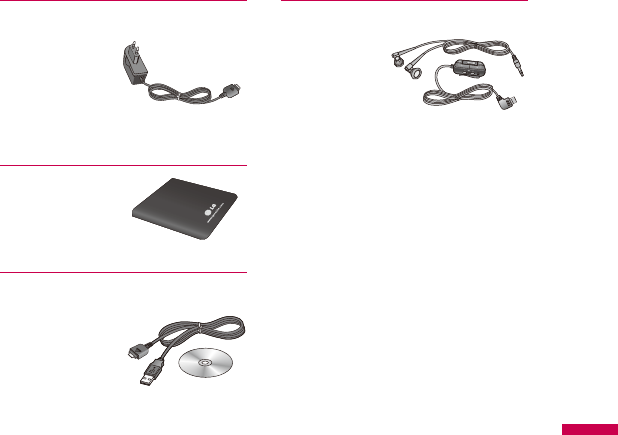
135
Travel Adapter
This charger
allows you to
charge the
battery while
away from home or your office.
Standard
Battery
Data cable/CD
You can connect
your phone to PC
to exchange the
data between
them.
Hands free earmicrophone
and music player
controller combo
v
Stereo headset
v
Controller: Answer & End
button, music player control,
volume control, Hold button and
microphone.
Accessories
ACCESSORIES
There are various accessories for your mobile phone. You can select these options
according to your personal communication requirements.

136
TECHNICAL DATA
Technical data
General
Product name: KS20
System: GSM900/DCS1800/PCS 1900, WCDMA 2100
Net weight: 92g (Without battery)
Ambient Temperatures
Normal: 55°C
Charging: 45°C